MANUAL
VoiSonaの
使い方を知ろう。
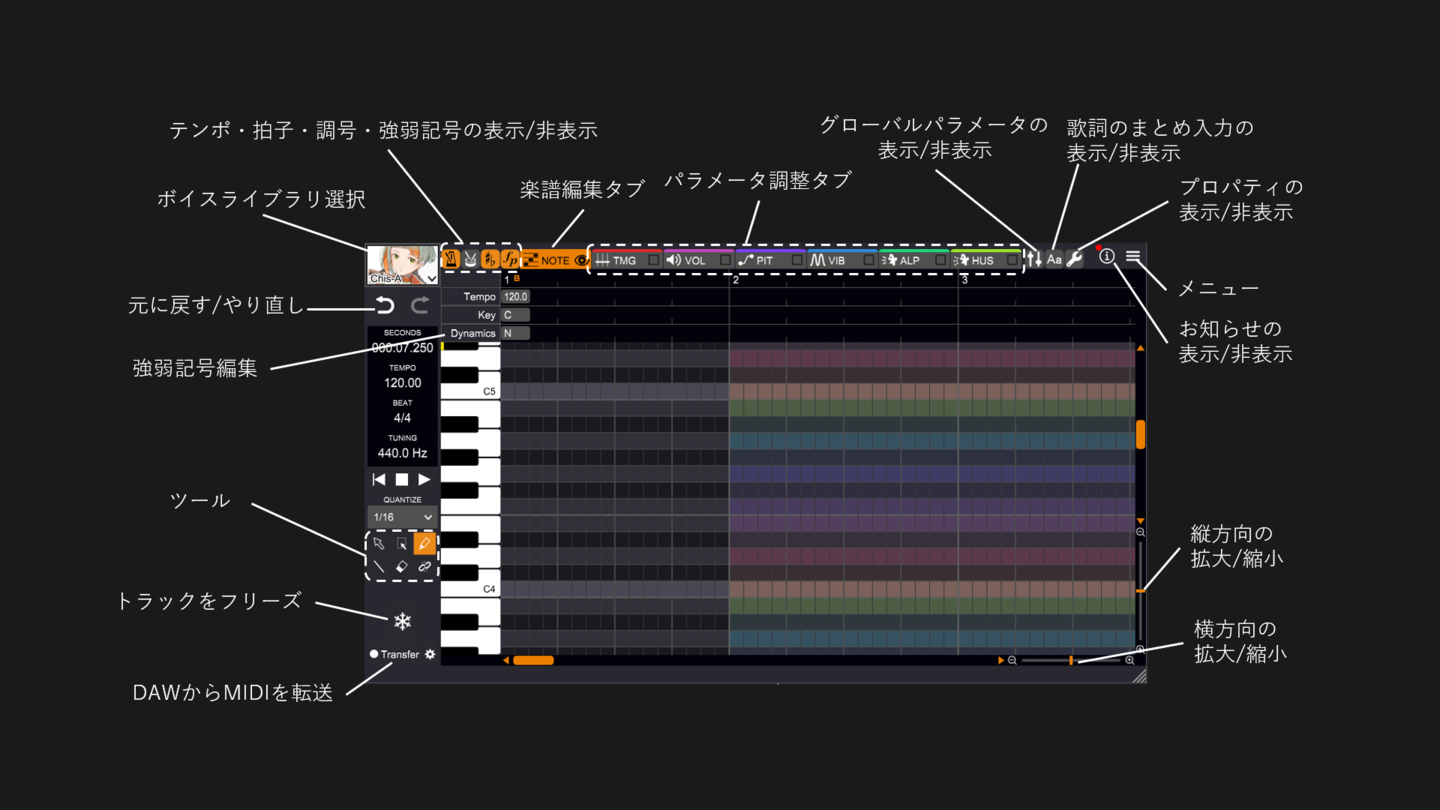
はじめてのソング作成
基本操作
使い方は簡単です。
ソングトラックを選択し、ピアノロール上をドラッグして音符を入力します。

音符をダブルクリックして、歌詞を入力します。

ピアノロールの上部で位置を指定し、再生ボタンを押すと再生されます。
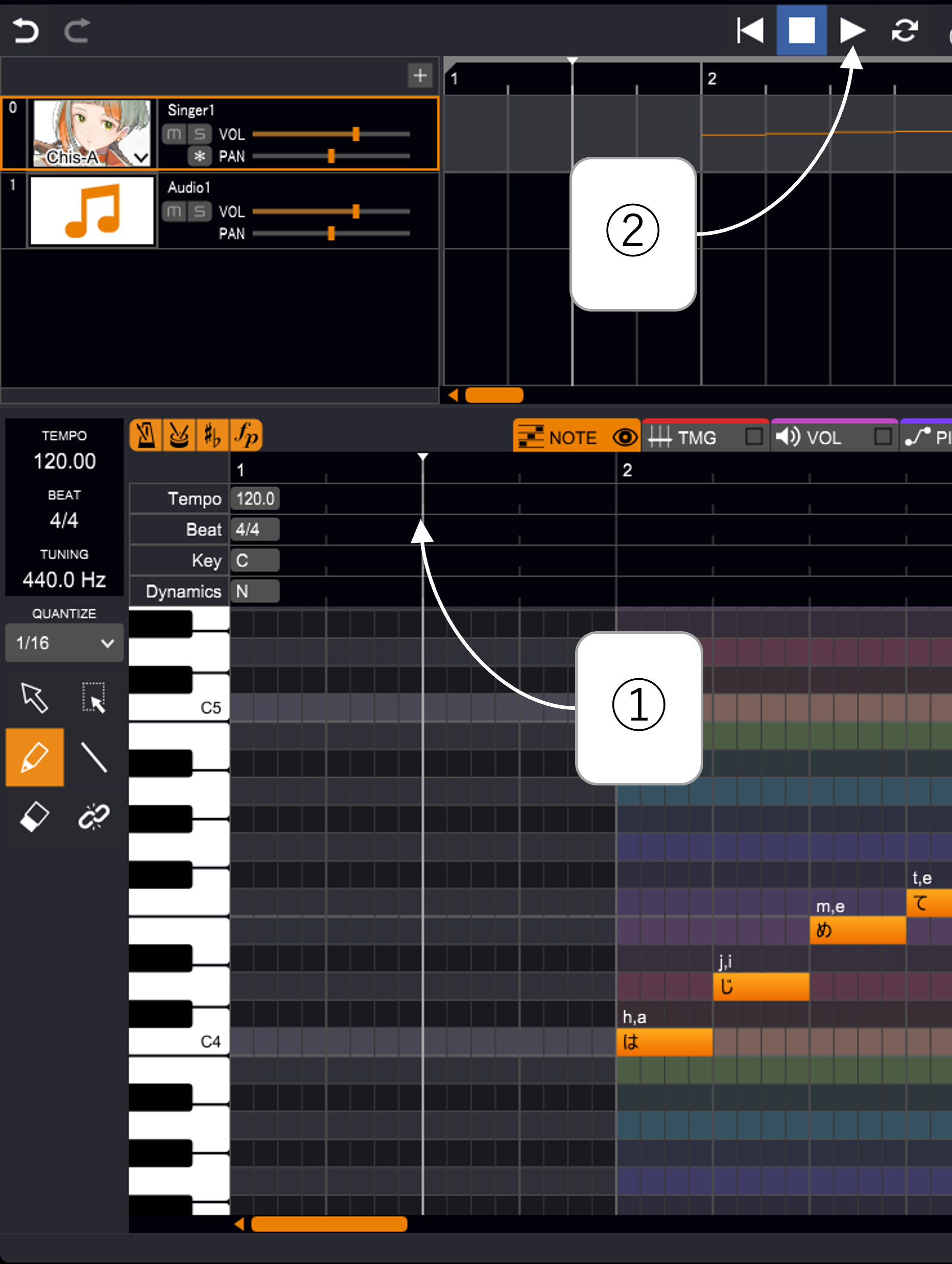
テンポ、拍子、調号、強弱記号は、各編集領域をダブルクリックすることで編集できます。
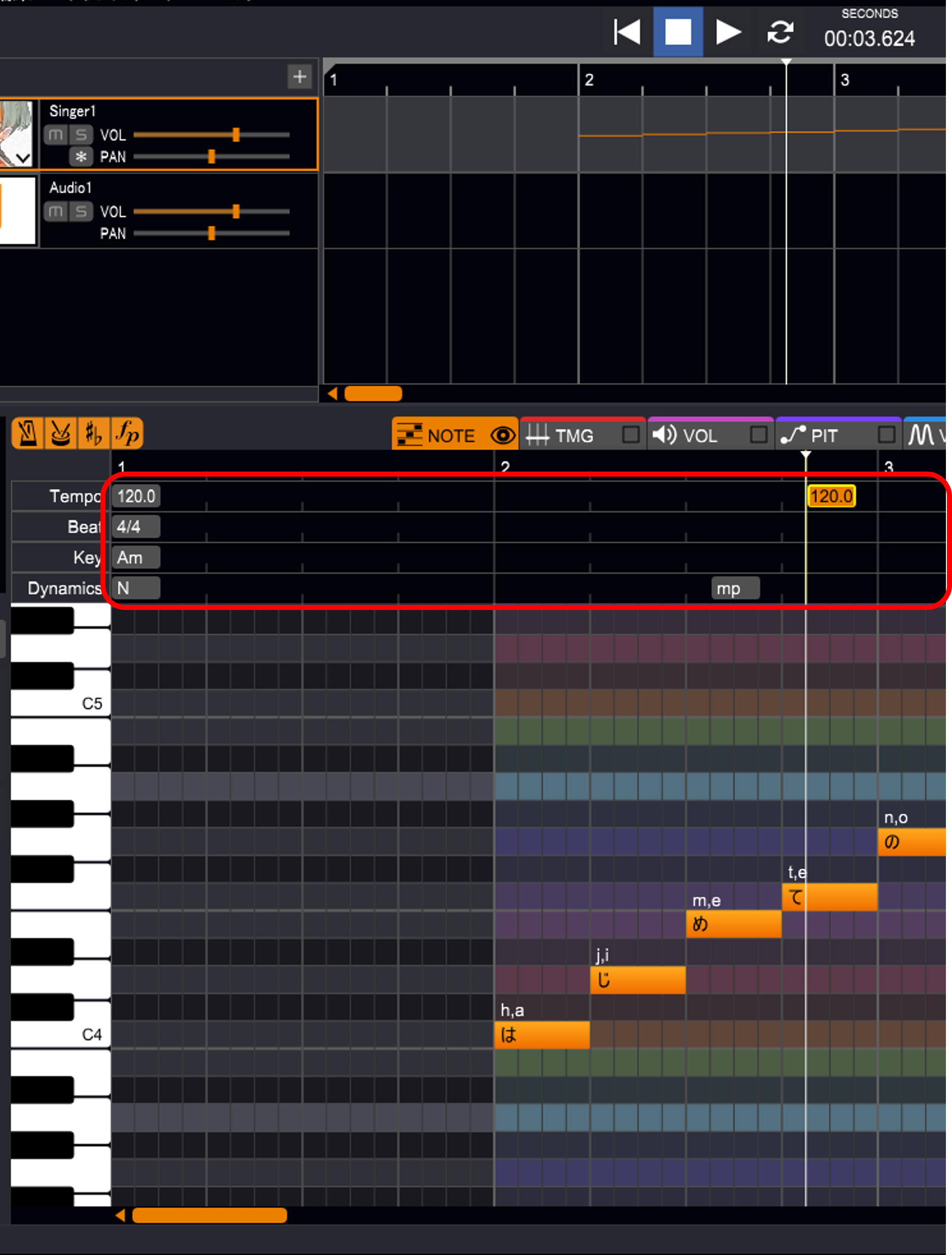
グローバルパラメータを表示すると、トラック全体にかかるパラメータが調整できます。
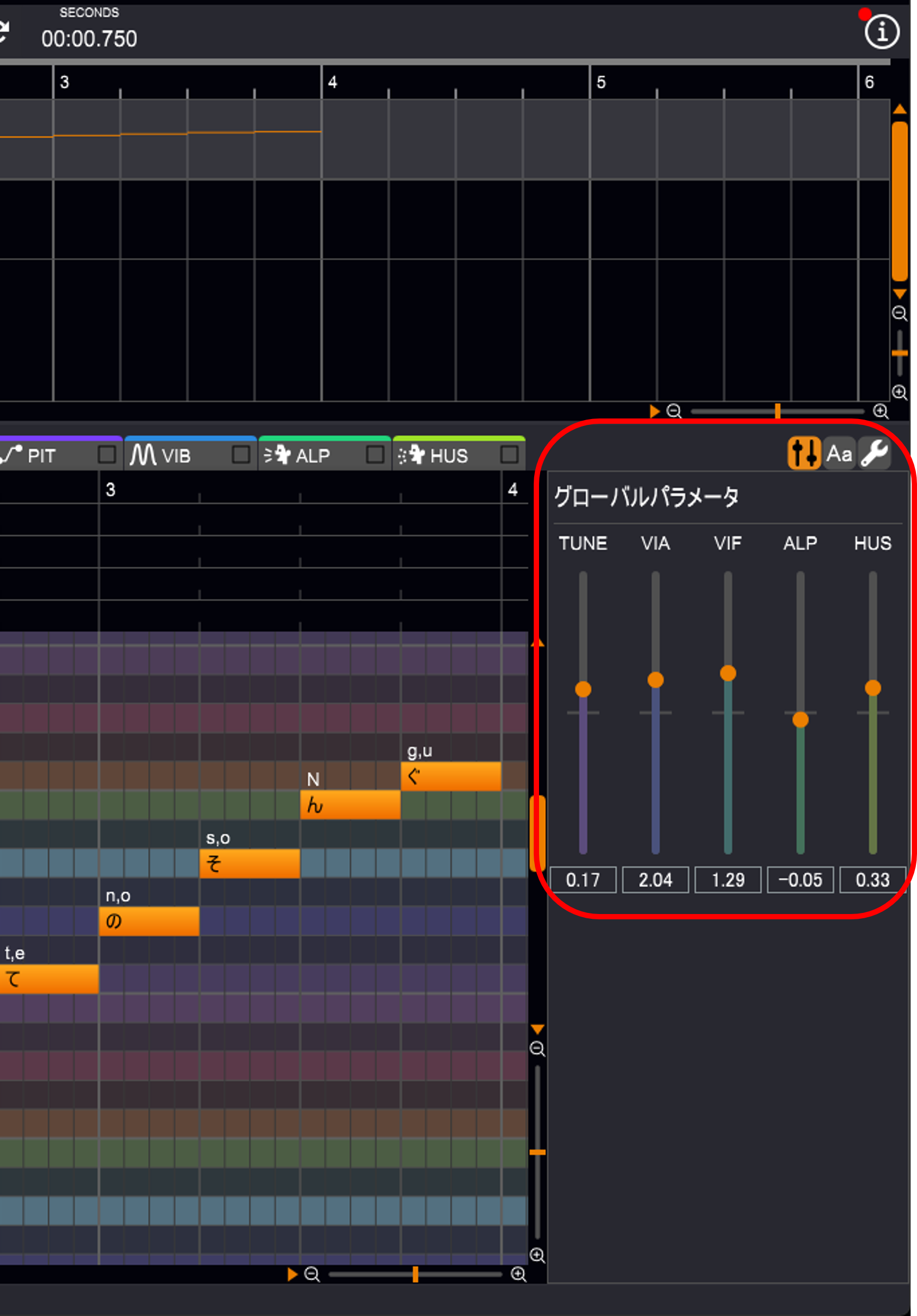
編集したデータをMusicXMLなどのファイルに出力したり、合成した音声をwavファイルとして出力することができます。

編集画面をタブで切り替えて細かい調整
パラメータ調整タブを切り替えると、細かい調整ができます。
TMGでは、縦ラインをドラッグすることで音素の開始/終了タイミングを調整できます。
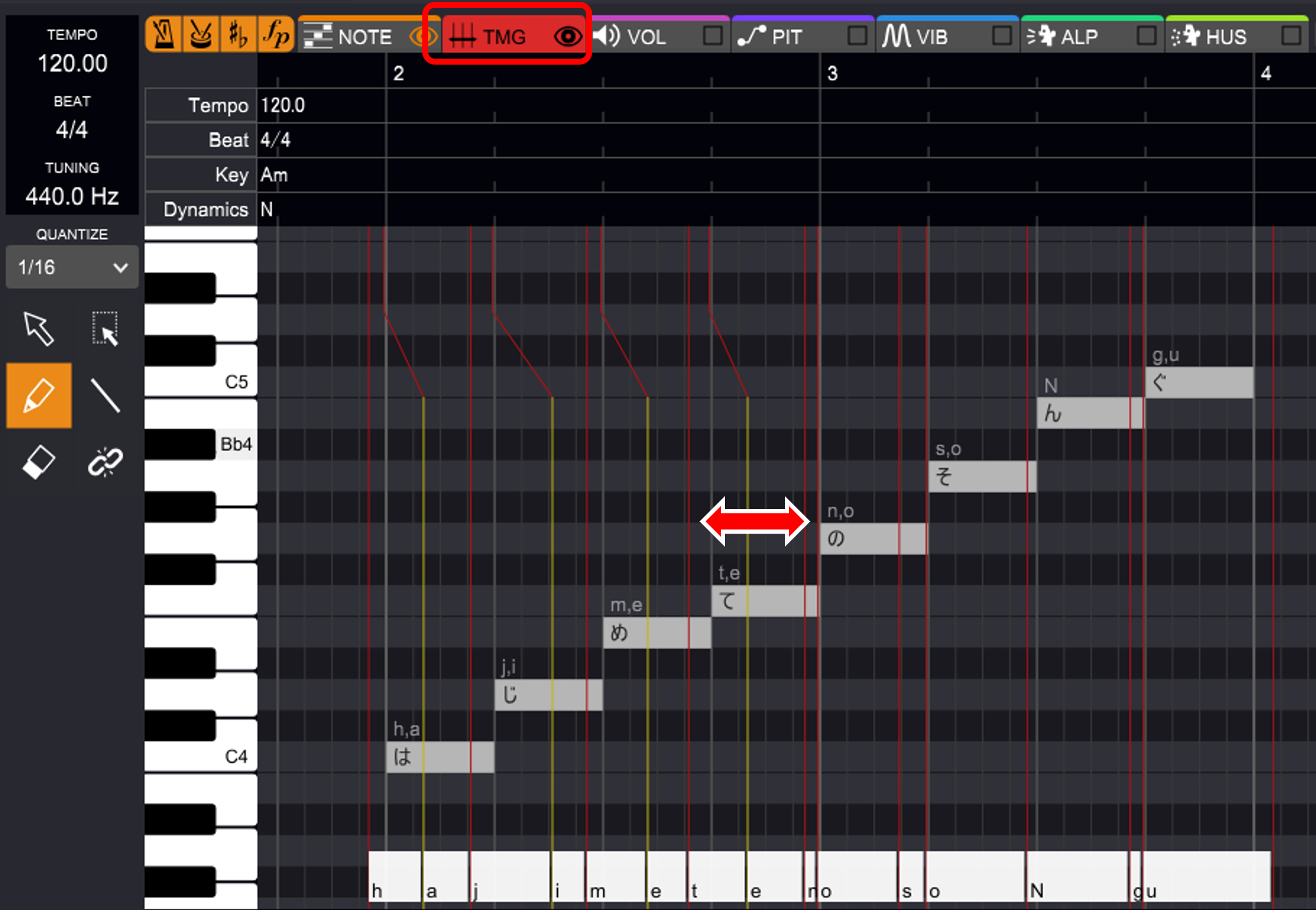
VOLは音量、PITはピッチ、VIBはビブラート、ALPは年齢感、HUSは声のハスキー具合の時間変化を、それぞれ描き込むことができます。

VIBは2つのモードがあり、Simplifiedモードではビブラートがかかっている区間が枠で表示されます。
この枠を操作することで周期や振幅、開始/終了位置を調整できます。

インストール・設定方法
インストール
VoiSonaをご利用いただくためには、PCをインターネットに接続し、下記の手順を行ってください。
ダウンロードページから最新バージョンをダウンロードします。
(アップデートの際も、インストールと同じ手順でご利用いただけます。)

インストール言語を選択して「OK」をクリックします。
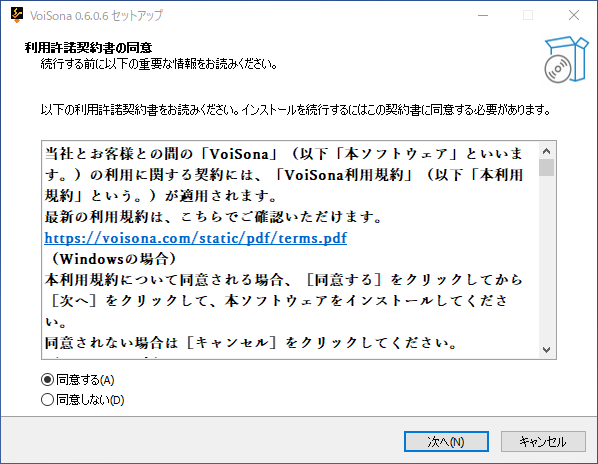
利用許諾契約書をご確認いただき、同意される場合は「同意する」にチェックして「次へ」をクリックします。
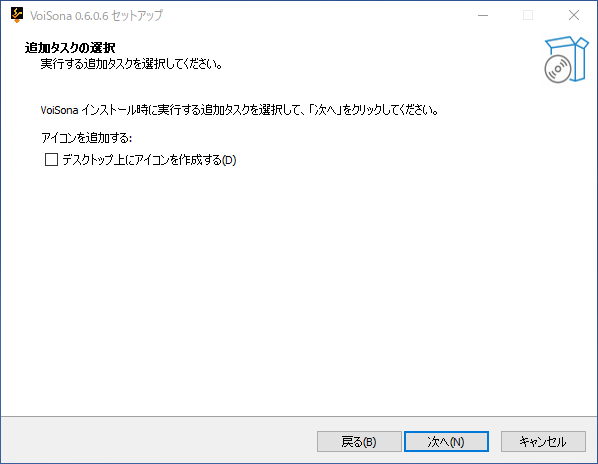
次へをクリックします。
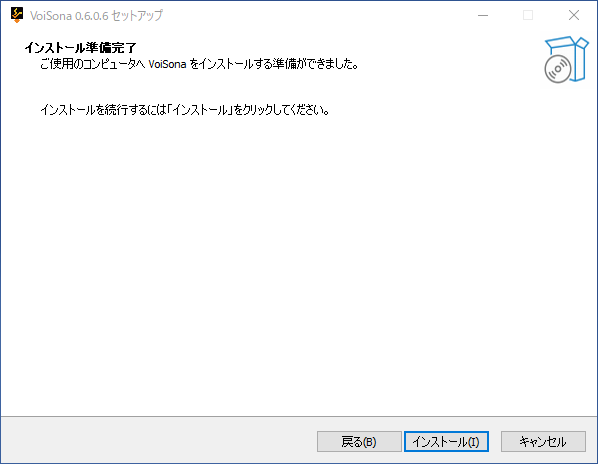
「インストール」をクリックします。
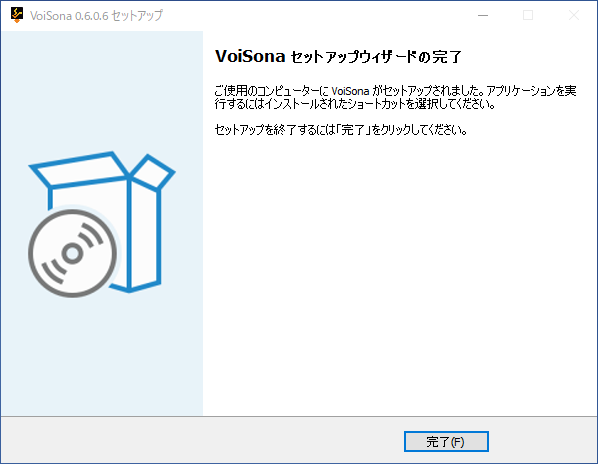
コンピューターを再起動するとインストールは完了です。「完了」をクリックします。
インストゥルメントプラグインとして利用する
VoiSonaはVST、もしくはAudio Units(AU)のインストゥルメントプラグインとしてDAW(Digital Audio Workstation)からご利用いただくことができます。
以下では例として、VSTのインストゥルメントプラグイン(VSTi)の形でCubaseから利用するための方法を解説します。
まず、Cubaseを起動し、「トラックインストゥルメントを追加」をクリックします。
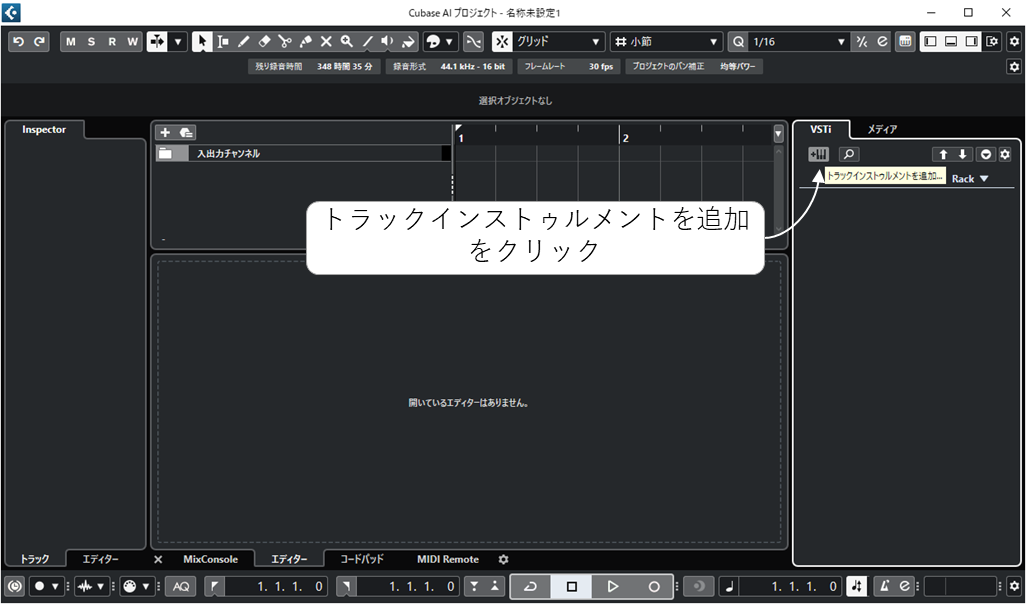
インストゥルメントから、「VoiSona Song Editor」を選択します。
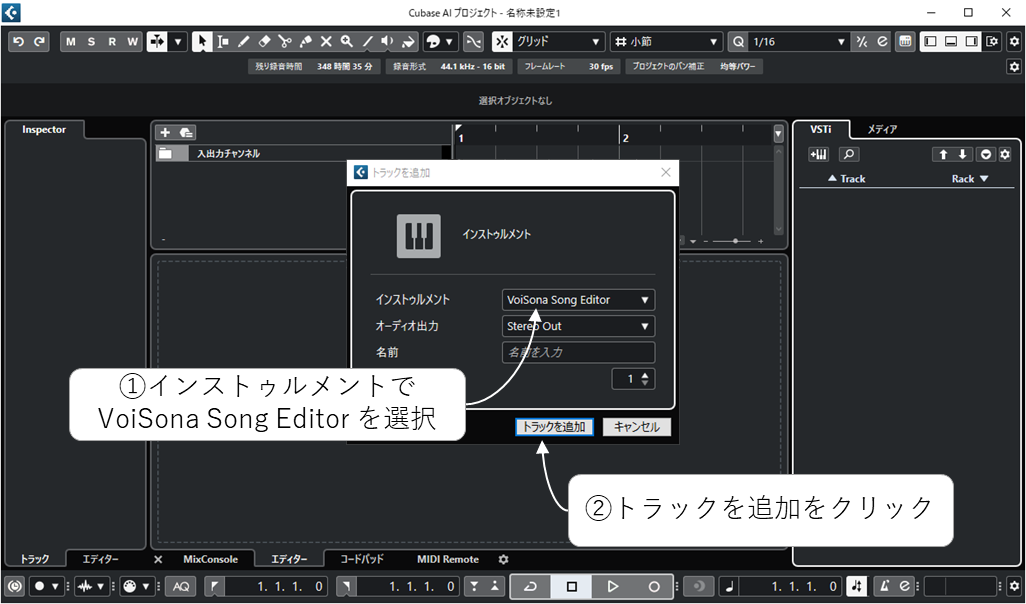
「トラック追加」をクリックすると、以下のようなVoiSonaの編集画面が表示されます。
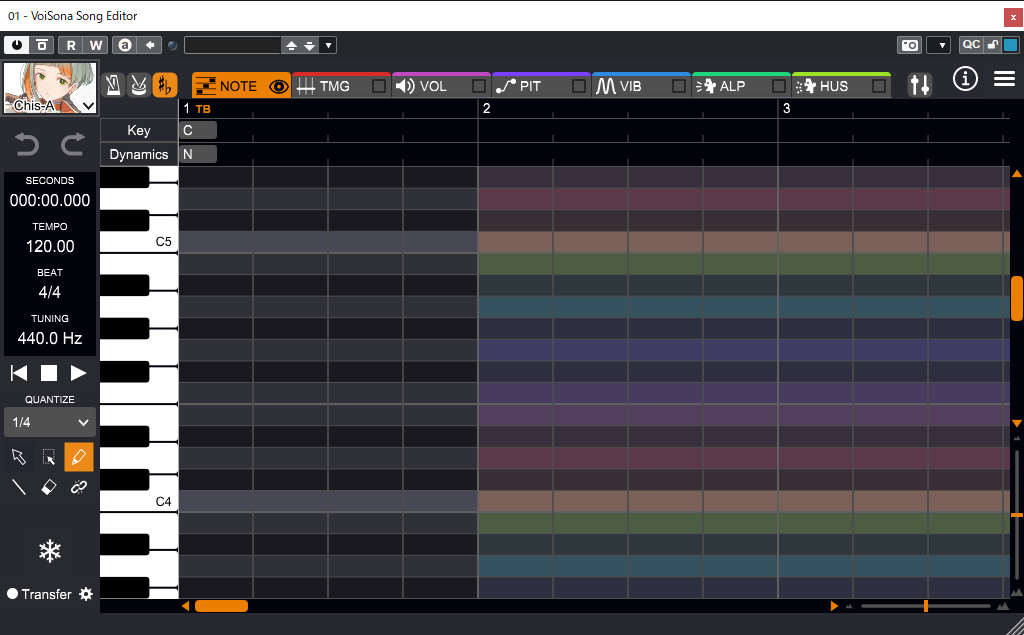
エフェクトプラグインとして利用する
VoiSonaはVST、もしくはAudio UnitsのエフェクトプラグインとしてDAWからご利用いただくこともできます。
(本機能は試験機能であり、ご利用いただけるのは有償ボイスライブラリをご利用中のユーザのみに限定させていただいております。)
以下では例として、VSTのエフェクトプラグイン(VSTe)の形でCubaseから利用するための方法を解説します。
まず、Cubaseを起動し、オーディオトラックを追加します。
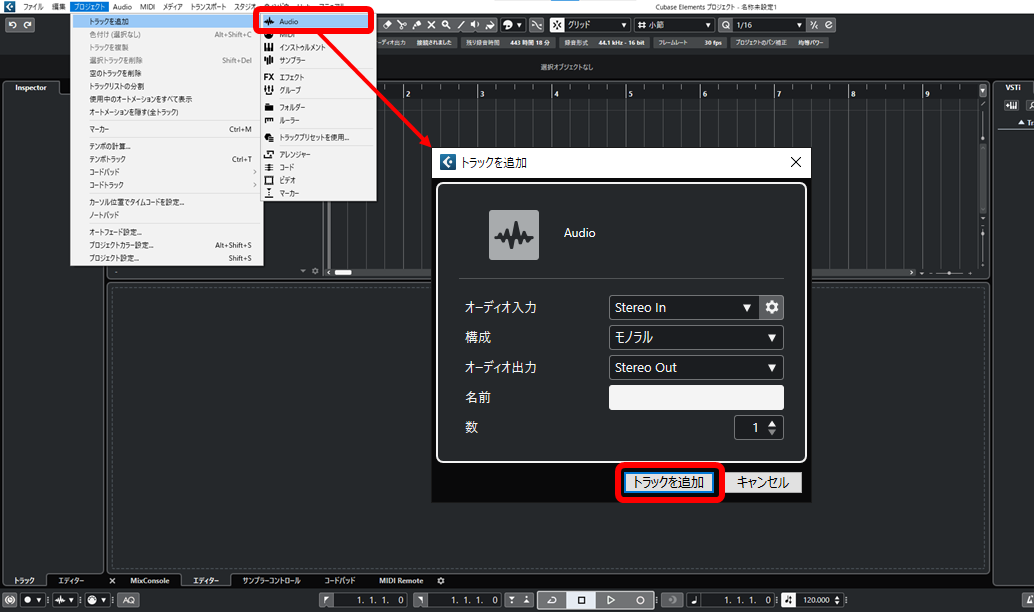
追加したオーディオトラックを選択した状態で、「Inspector」>「Inserts」にてプラグインを挿入したい位置をクリックします。
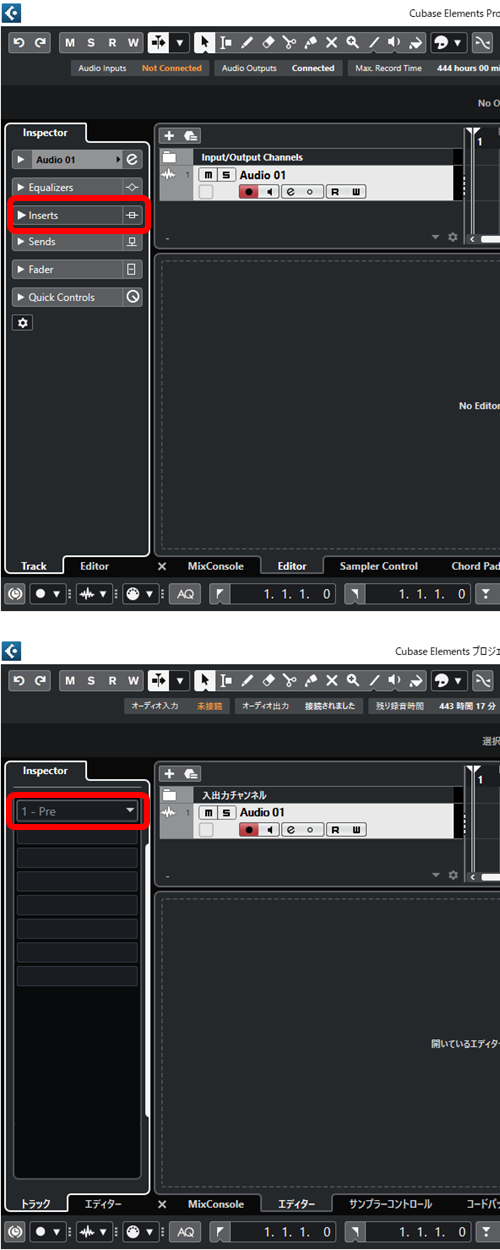
表示されたエフェクト一覧の中から「VoiSona Song Editor(Effect)」をクリックすると、以下のようなVoiSonaの編集画面が表示されます。
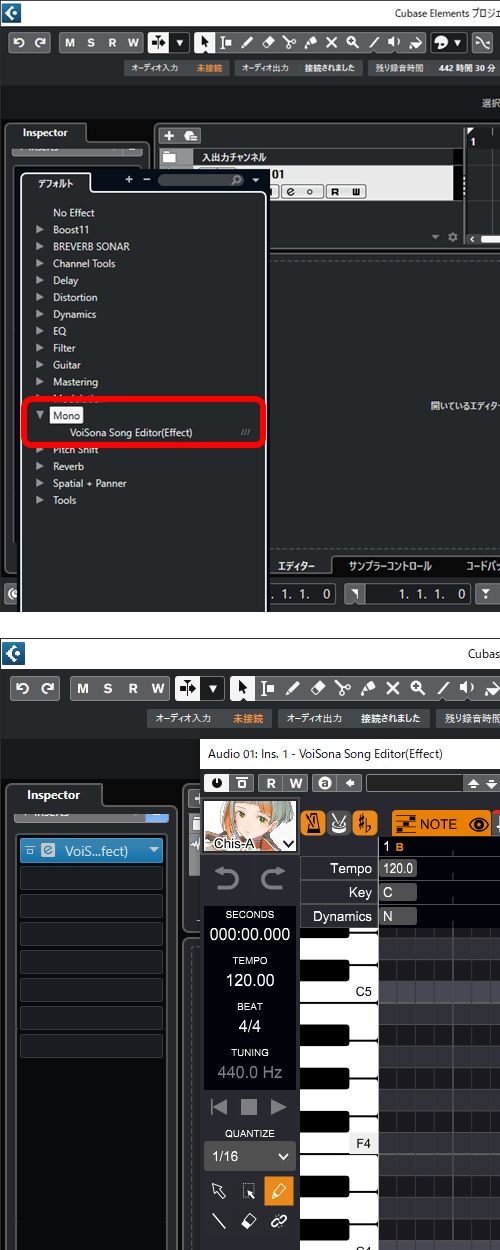
※Logic ProやGarageBand、またはCubaseでエフェクトプラグインとして利用する場合は、プラグインの入力となるオーディオトラックに何らかのオーディオ(例えばwavファイル)を設定しておく必要があります。オーディオが設定されていない範囲は音声が出力されないためご注意ください。
スタンドアローンで利用する
DAWをお持ちで無い場合にもお気軽にお試しいただけるように、スタンドアローン版もご用意しております。
まず、インストールしたVoiSonaを起動します。
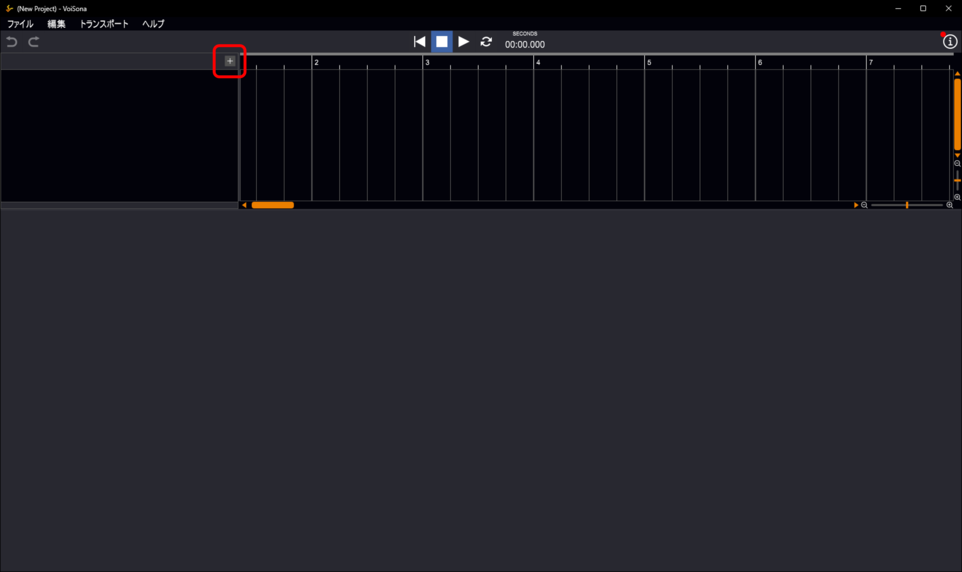
「+」マークをクリックします。
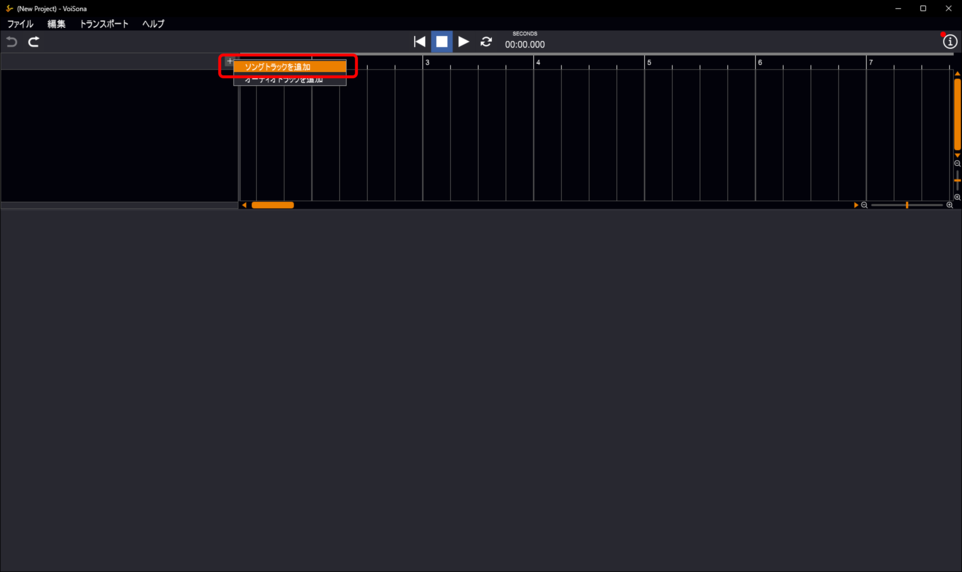
「ソングトラックを追加」を選択します。
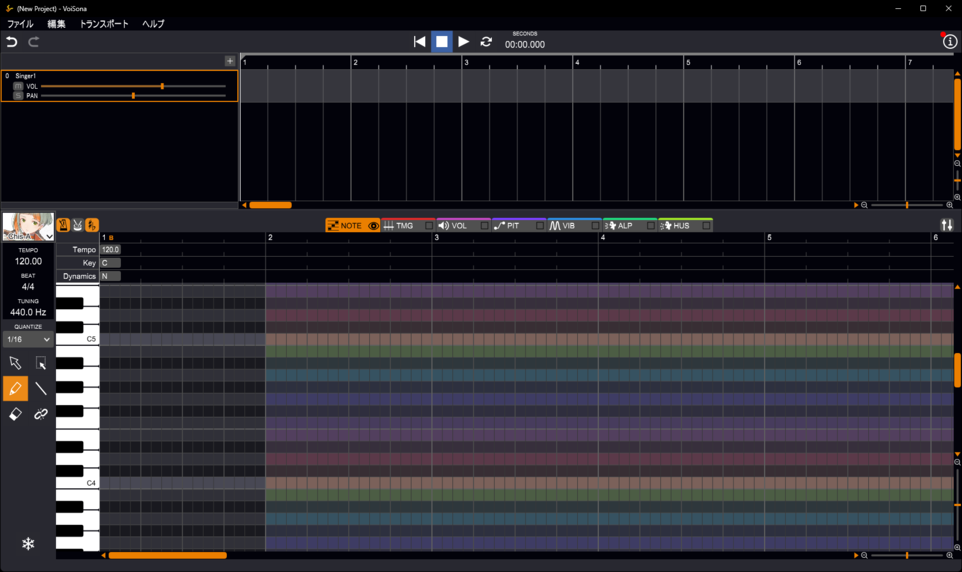
追加したソングトラックを選択することで、VoiSonaの編集画面が表示されます。
編集画面の説明
ボイスライブラリの選択
ライブラリのプルダウンをクリックすると、利用できるボイスライブラリの一覧が表示され、ボイスライブラリを選択することができます。まだダウンロードされていないボイスライブラリには、右側にダウンロードボタンが表示されますので、ダウンロードしてご利用ください。
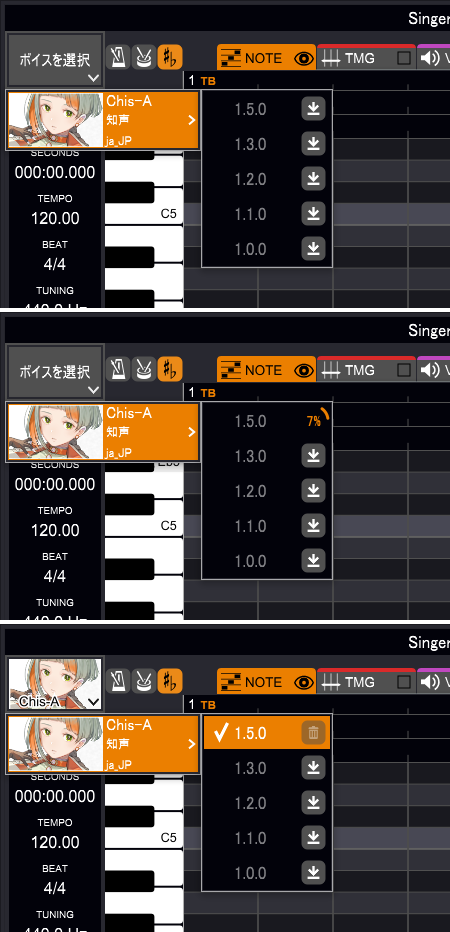
ボイスライブラリによっては、起動中のエディタのバージョンが古いため非対応のものが存在します。
その場合は表示されているボタンをクリックしてダウンロードページに移動し、VoiSonaを最新版にアップデートしてください。
アップデート後にVoiSonaを起動すると、ダウンロードボタンが表示されるようになります。
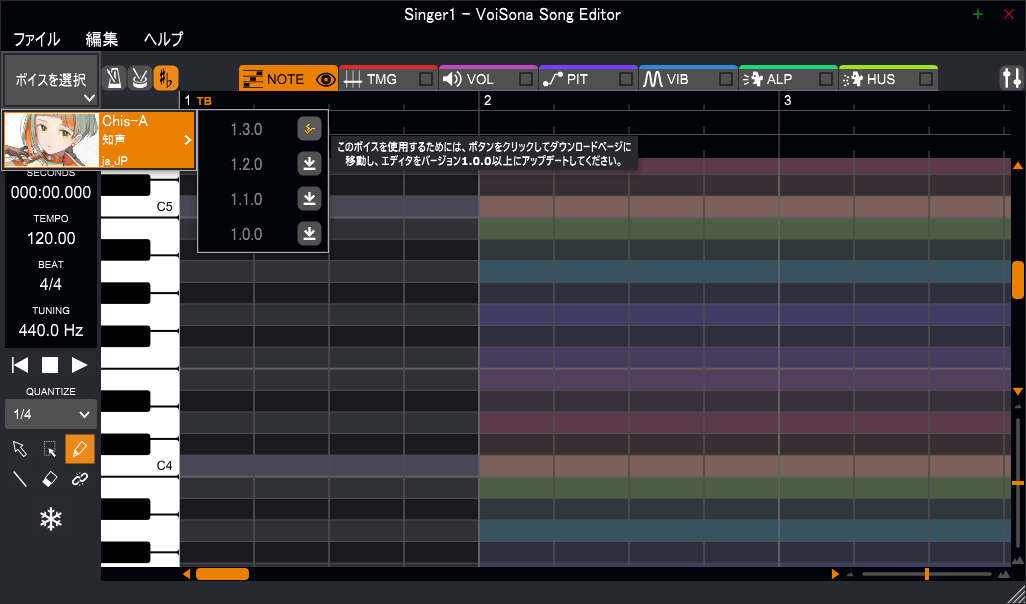
テンポ・拍子・調号・強弱記号の編集
テンポ、拍子、調号のボタンをクリックすると、各編集領域の表示/非表示を切り替えることができます。
各編集領域をダブルクリックすると、記号が挿入され編集することができます。
上手に歌わせるためには正しい調号の指定が重要となります。
また、強弱記号を指定することで、歌声にメリハリを付けることができます。
※ボイスライブラリや楽譜によっては、強弱記号の効果がわかりにくいことがあります。
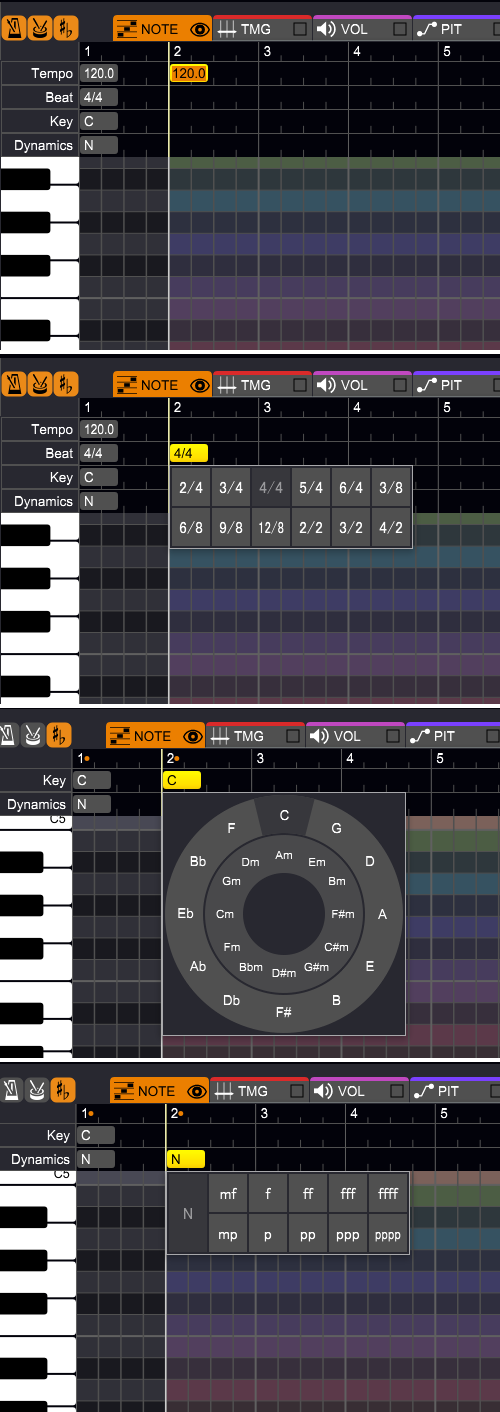
グローバルパラメータ
曲全体に関わるパラメータを編集します。
・TUNE:楽譜の音高への忠実度。下げると楽譜の音高から離れ、上げると楽譜の音高に近づく。
・VIA:ビブラートの振幅。上げると大きくなる。
・VIF:ビブラートの周期。下げると緩やかに、上げると細かくなる。
・ALP:声質。下げると子供っぽく、上げると大人っぽくなる。
・HUS:ハスキー具合。上げるとハスキーになる。
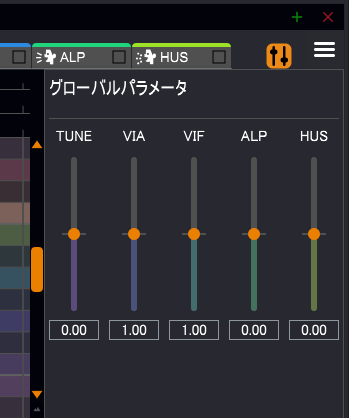
基準ピッチ
曲全体の基準ピッチを編集します。
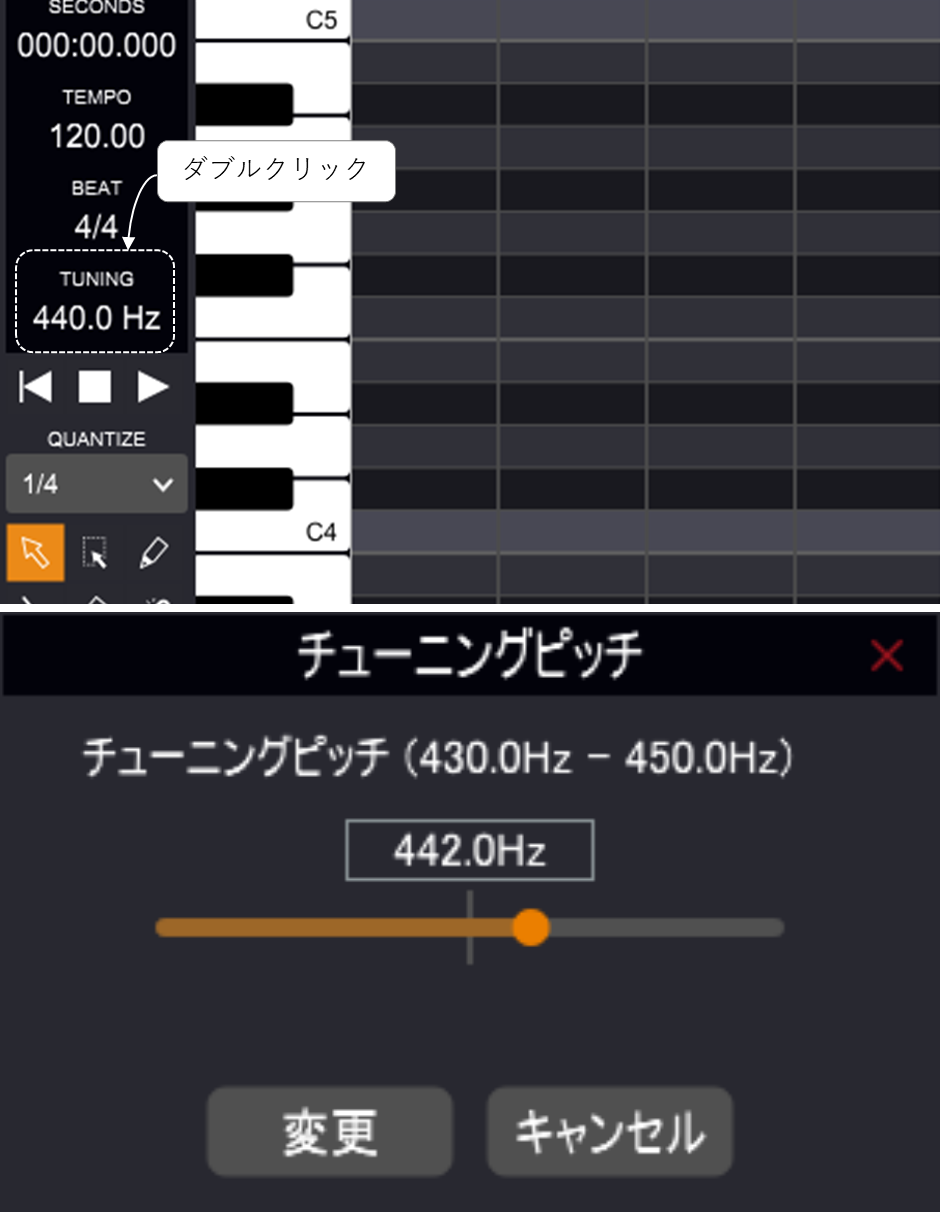
トラックをフリーズ
通常、音声合成処理は再生時にリアルタイムに行われますが、PCによっては負荷が高くて再生がとぎれとぎれになることがあります。
その場合は、フリーズ機能であらかじめ音声合成を済ませておき、再生時の負荷を軽くすることができます。
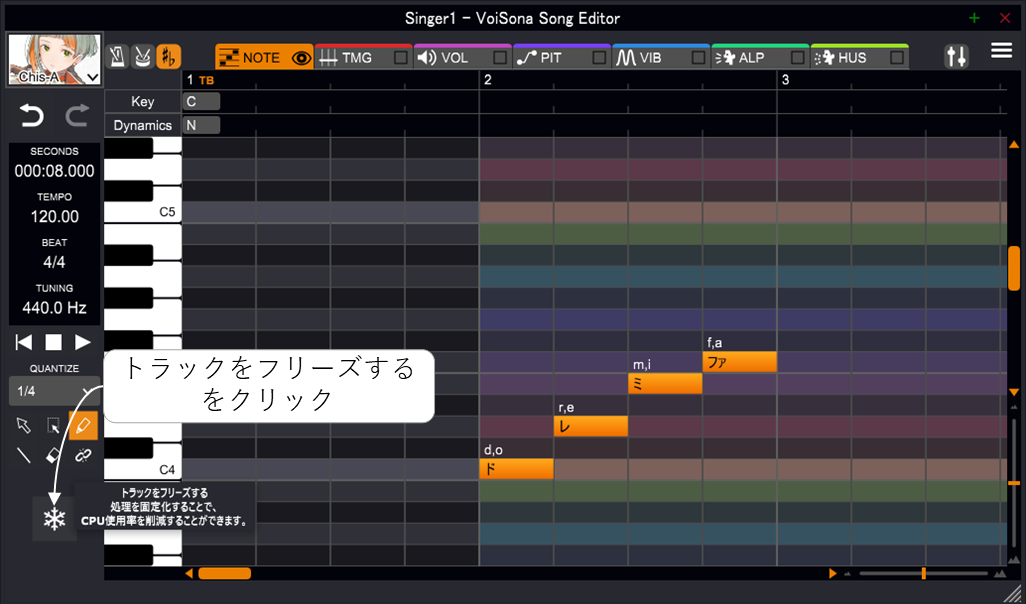
「フリーズ」ボタンをクリックすると、合成処理が行われます。PCの性能によりますが、これには時間がかかることがあります。
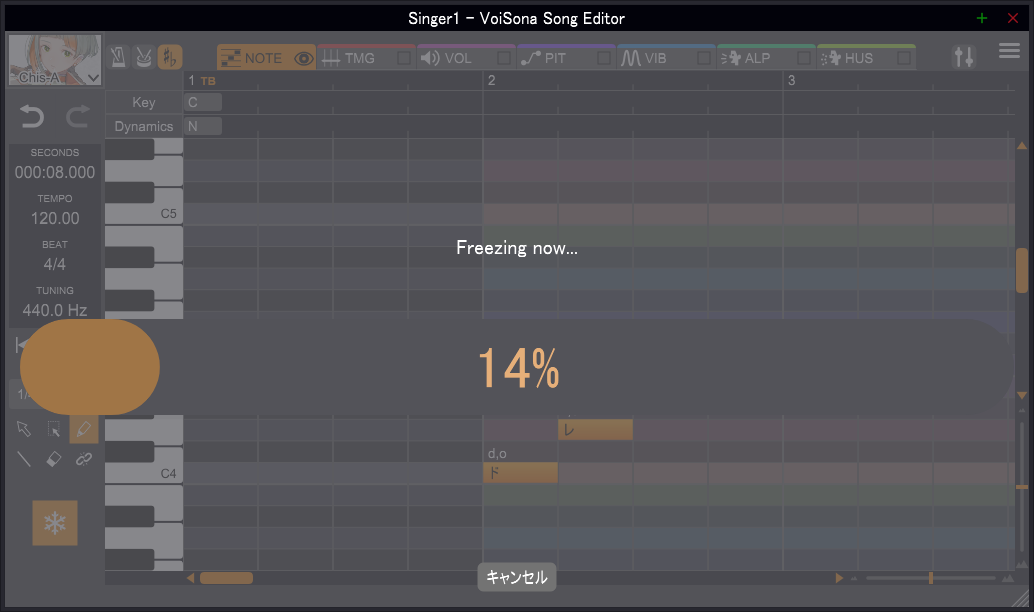
合成処理が終わると、「トラックをフリーズ」ボタンがオレンジ色に変わり、フリーズされた状態となります。
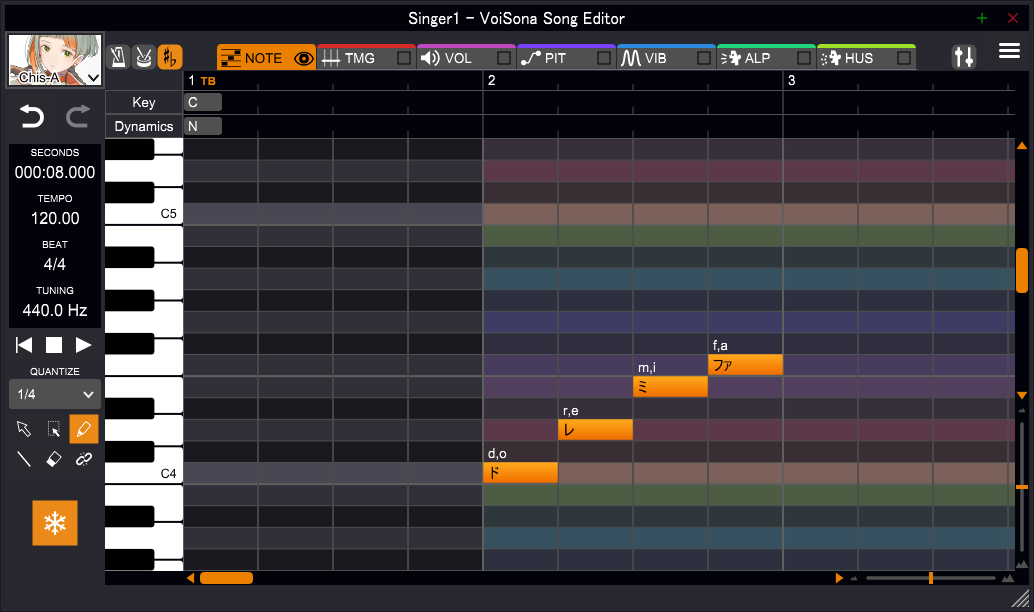
DAWからMIDIを転送
DAWで入力したMIDI情報をVoiSonaに転送することができます。
再生した区間のMIDI情報のみがVoiSonaに反映されますのでご注意ください
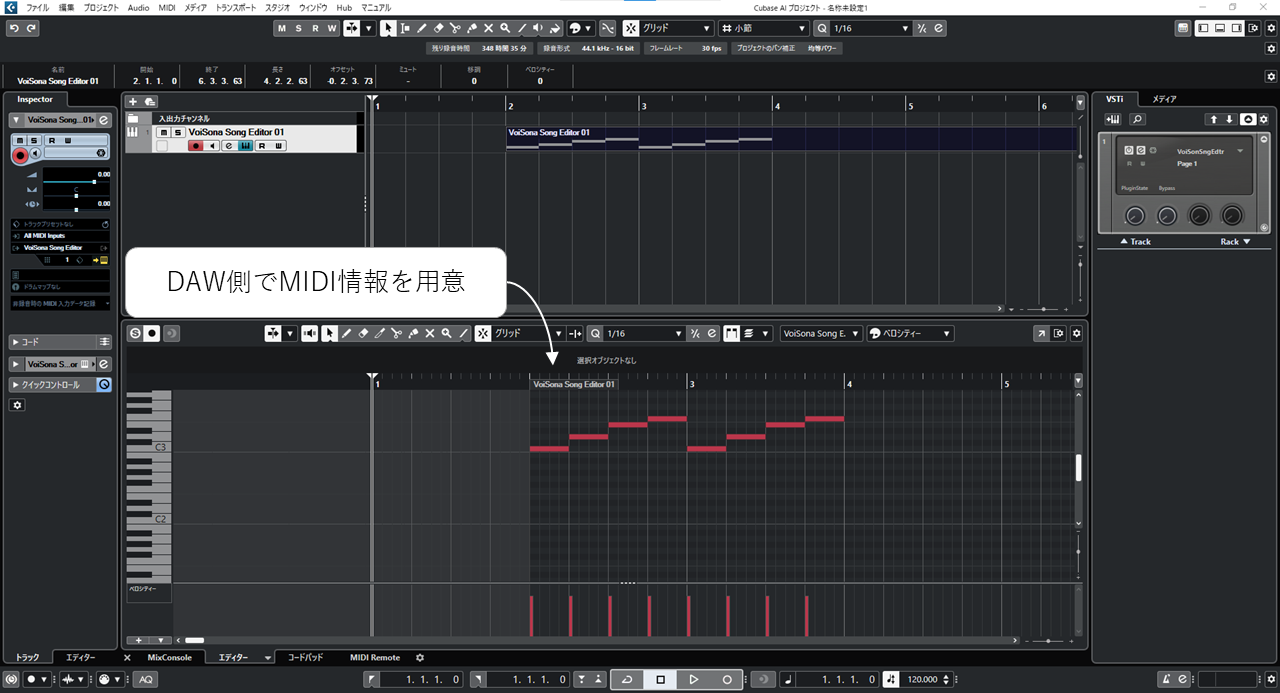
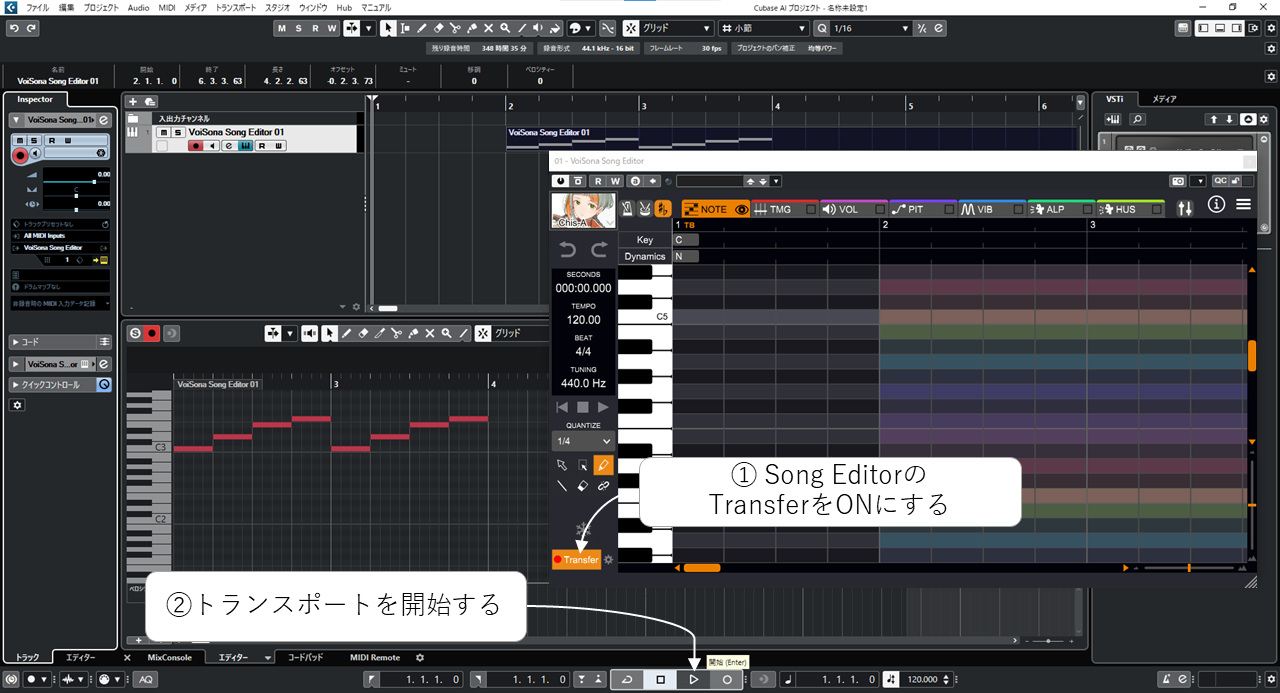
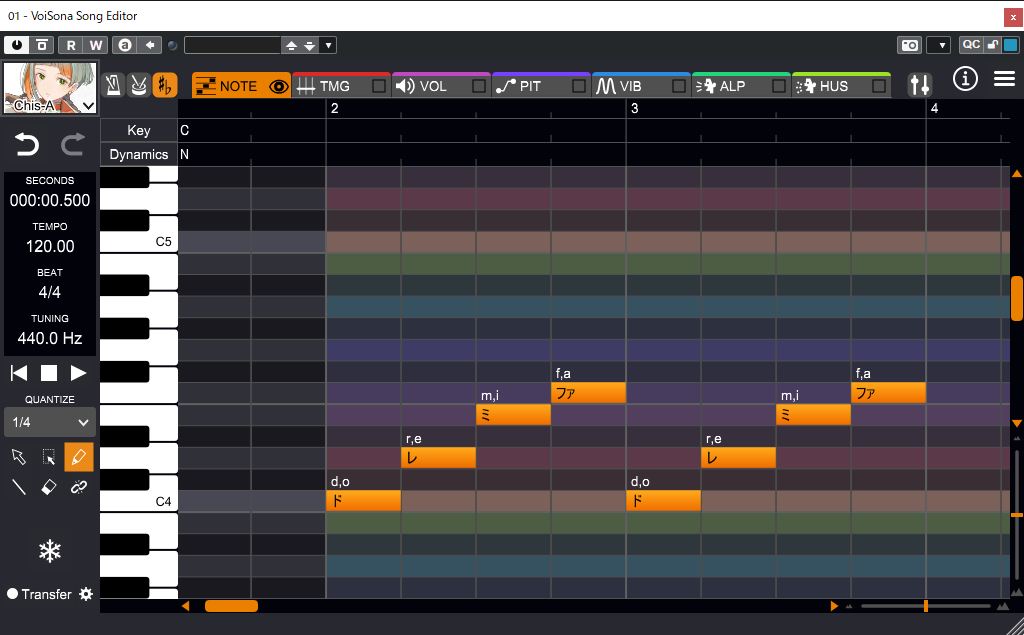
オーディオ入力
VoiSona Song Editor(Effect)では、通常の合成処理に加えて、「オーディオ入力」ボタンをONにすることで、オーディオ入力に歌声を付加することができます。
(本機能は試験機能であり、ご利用いただけるのは有償ボイスライブラリをご利用中のユーザのみに限定させていただいております。)
※オーディオ入力が有効のとき、PITやHUSパラメータなど一部機能が無効になります。
※オーディオ入力機能は48kHz推奨です、48kHz以外のサンプリングレートを設定した場合は若干の遅延が発生します。
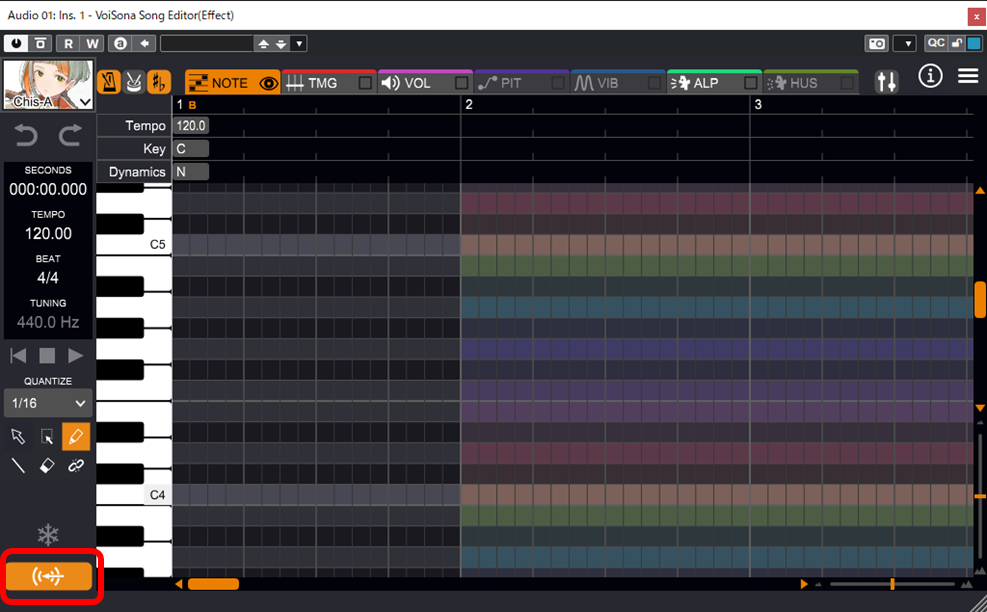
インポート
メニューの「ファイル」から「インポート」を選択します。以下に対応しています。
・tssprj:VoiSona独自形式のプロジェクトファイルを入力。
・CCS/CCST:CeVIO Creative Studio、CeVIO AIのプロジェクトファイルを入力。
・Music XML:Music XML形式の楽譜を入力。
・MIDI:MIDIファイルを入力。トラックを選択可能。
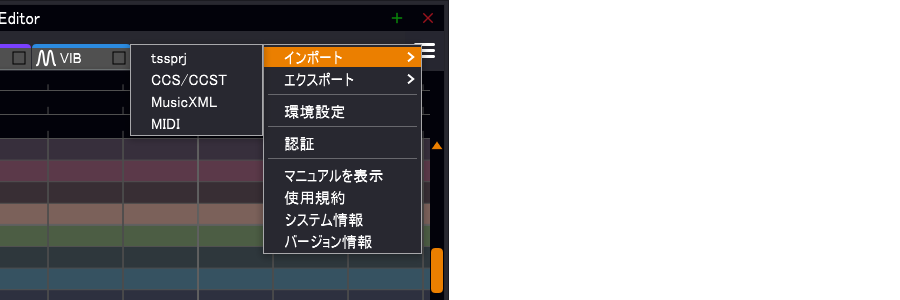
エクスポート
メニューの「ファイル」から「エクスポート」を選択します。以下に対応しています。
・tssprj:VoiSona独自形式のプロジェクトファイルを出力。
・CCS/CCST:CeVIO Creative Studio、CeVIO AIのプロジェクトファイルを出力。
・Music XML:Music XML形式の楽譜を出力(調整パラメータ等は出力されないので注意)。
・MIDI:MIDIファイルを出力。
・WAV:合成音声波形を出力。オプションでlabファイルを同時に出力可能。
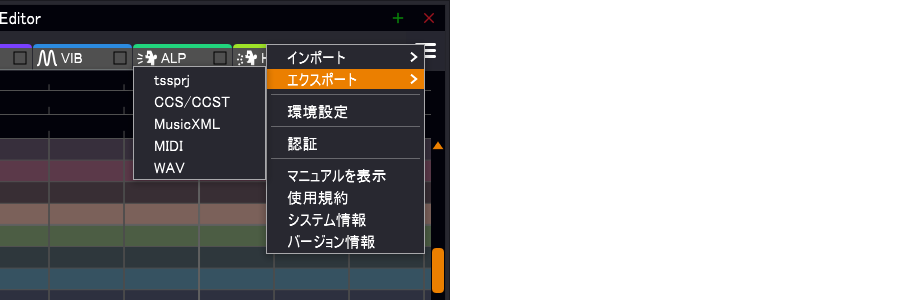
環境設定(ショートカットキー等)
メニューの「編集」から「環境設定」を選択します。言語設定、エディタ全体の設定、ショートカットキーの設定が可能です。
ショートカットキーを使いこなすことで創作速度が上がりますので、ぜひご利用ください。

楽譜編集
音符の入力・削除
音符を入力するときは、ツールからペンツールを選択します。音符を置きたい場所を左右にドラッグすることで、音符を入力することができます。
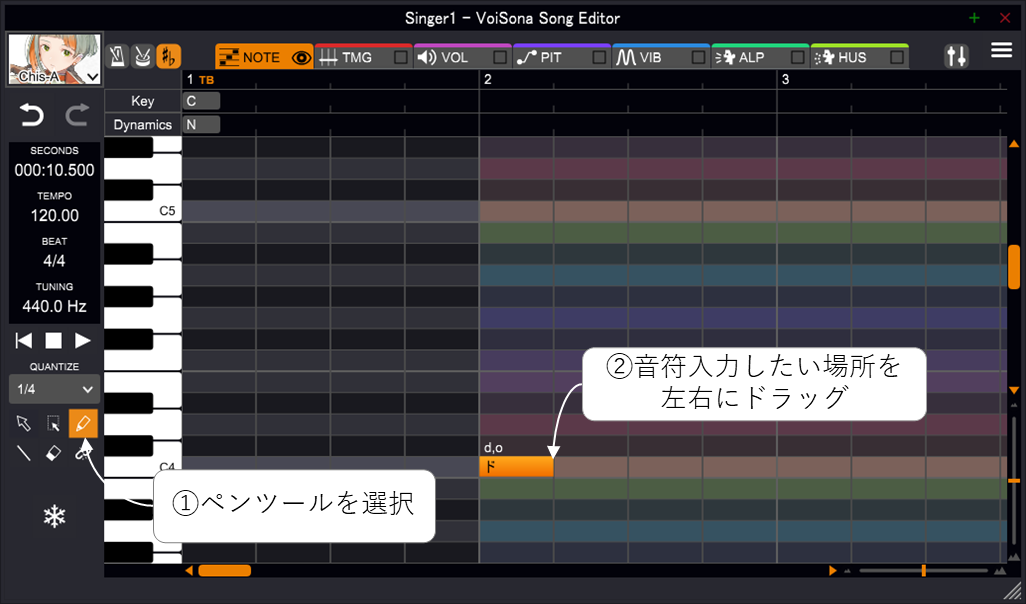
編集画面左側のQUANTIZEプルダウンリストから、音符のクオンタイズ設定を変更することができます。
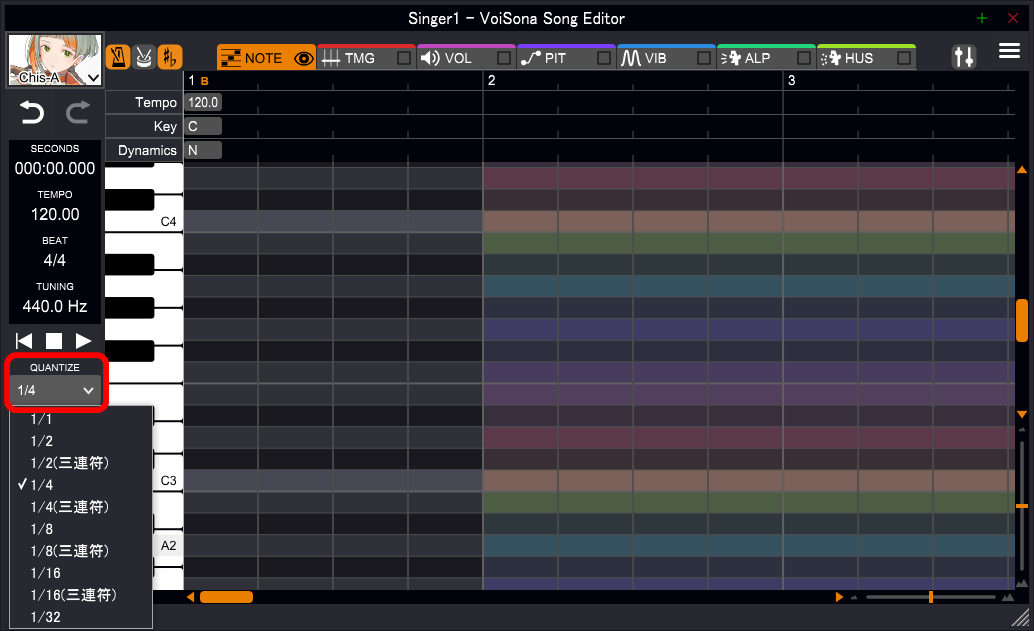
音符を削除するときは、ツールから消しゴムツールを選択します。消したい音符をクリックすることで、音符を削除することができます。
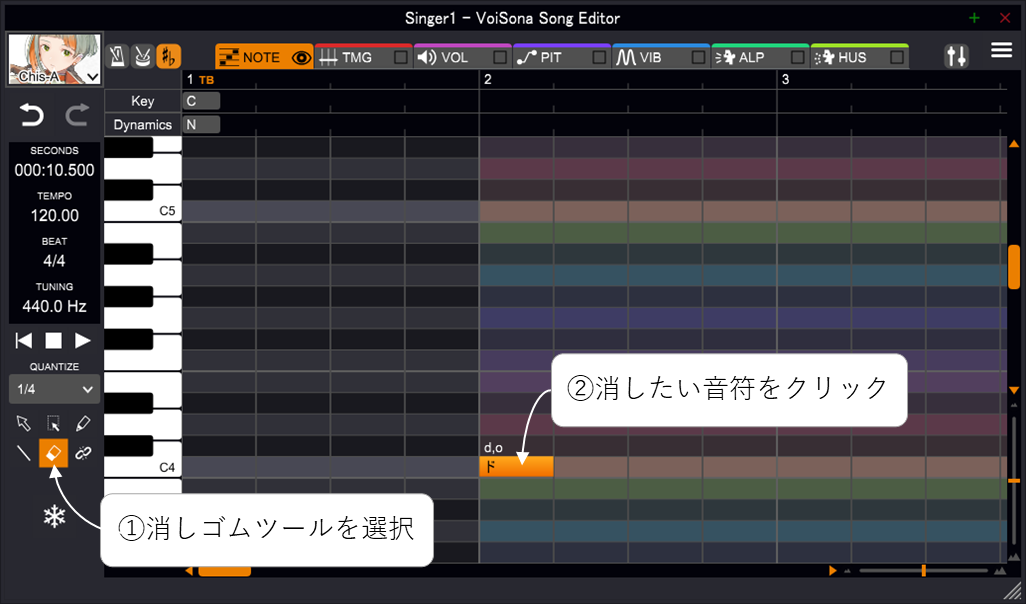
また、Ctrlキーを押している間だけ別のツールに切り替えることができます。
選択ツール、まとめ選択ツール、分割結合ツールのときはペンツールに切り替わります。
ペンツールもしくはラインツールのときは消しゴムツールに切り替わります。
消しゴムツールのときは選択ツールに切り替わります。
楽譜編集画面では、他のトラックで入力した音符も表示されます。
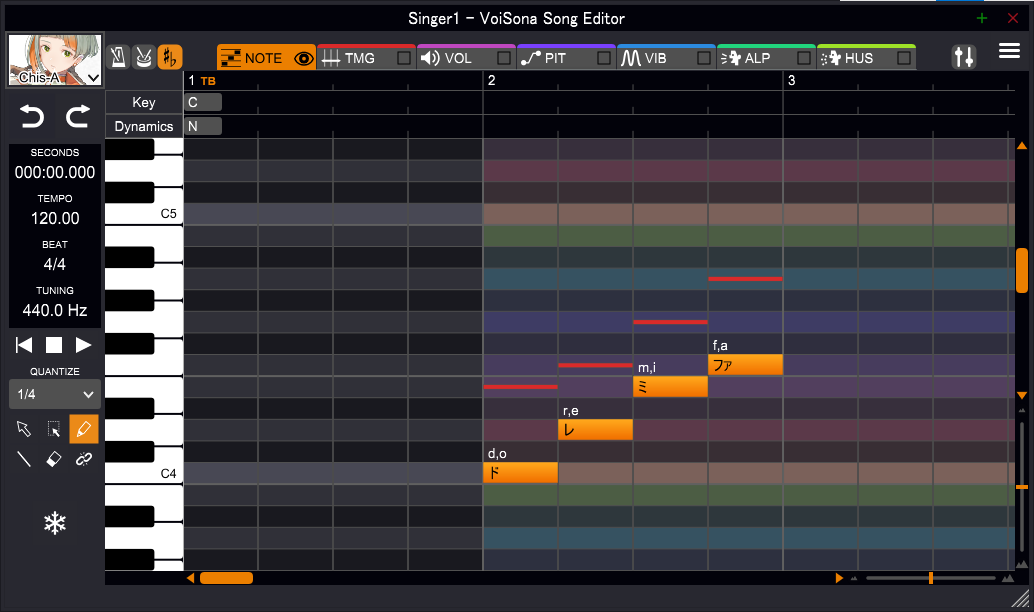
音符の編集(音高・長さ)
音符を上下にドラッグすると、音高を変更することができます。
音符の端を左右にドラッグすると、音符の長さを変更することができます。
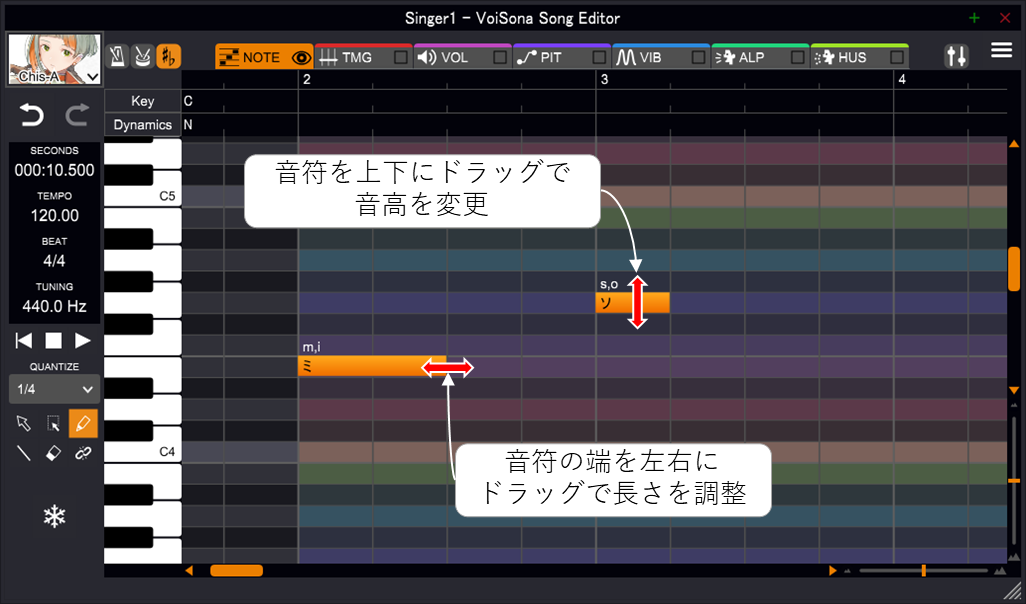
まとめて選択することで、複数の音符を同時に移動やコピー、削除することができます。
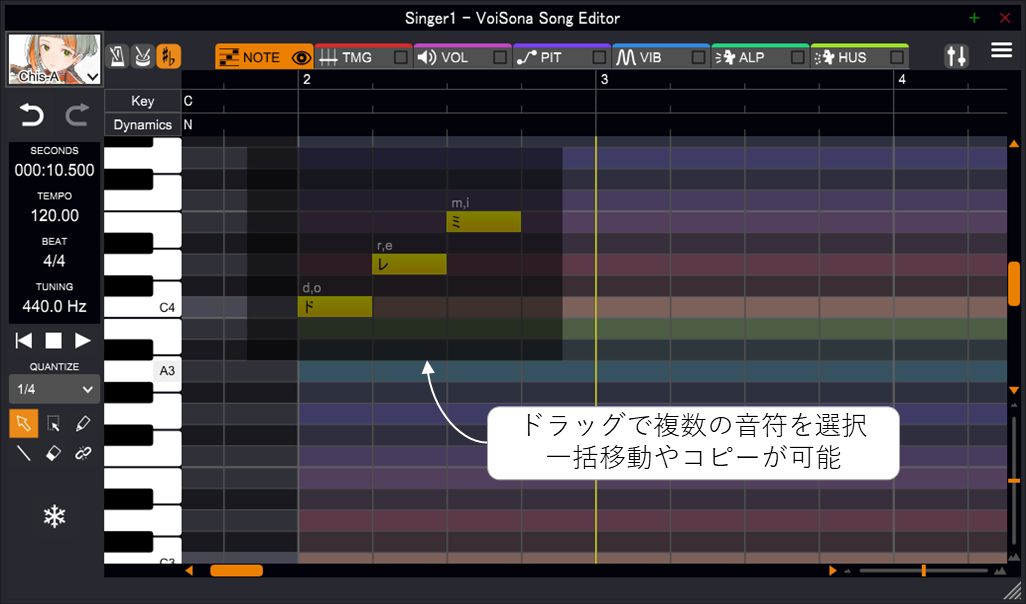
音符の分割・結合
音符の分割・結合をするときは、ツールから分割結合ツールを選択します。
音符中の分割したい位置でクリックすると、音符を分割することができます。
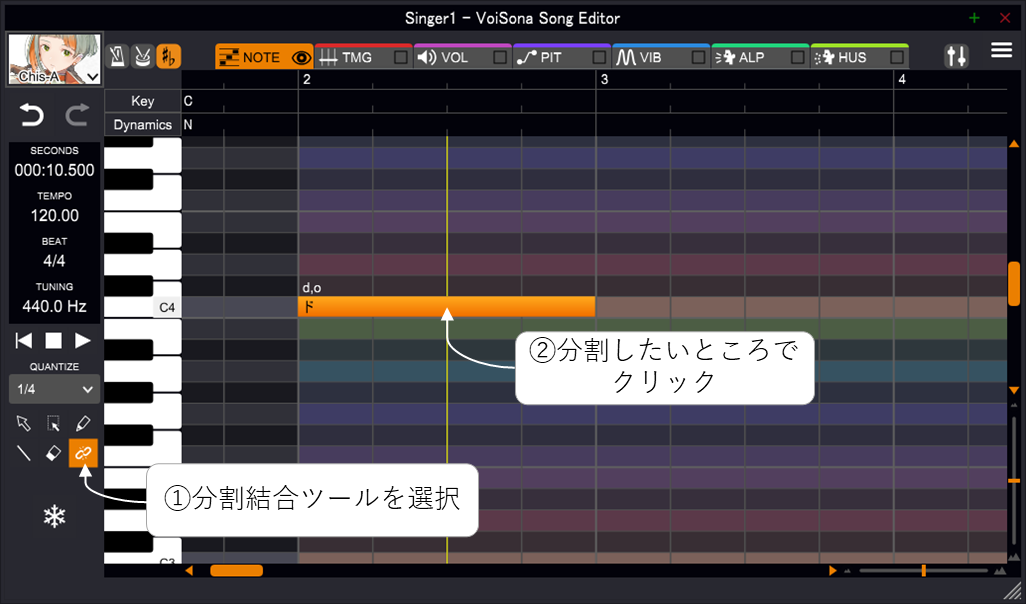
音符の端をクリックすると、前後の音符と結合することができます。
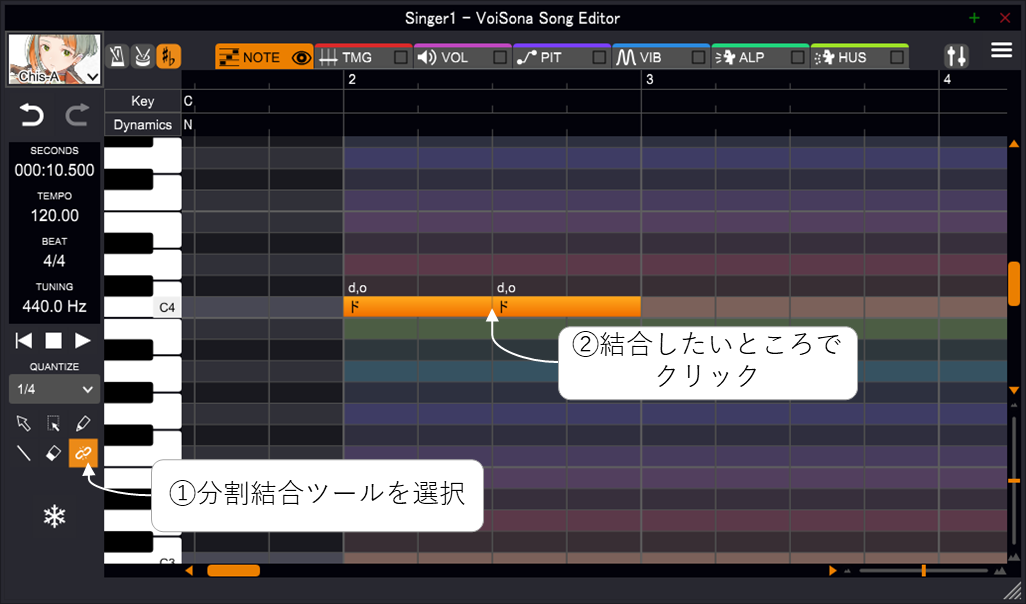
歌詞の入力
音符をダブルクリックすると歌詞を入力することができます。Tabキーで次の音符へ、Shift+Tabキーで前の音符へ移動します。
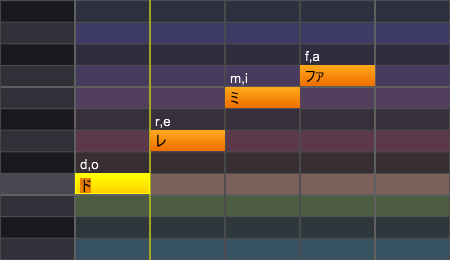
英語歌詞を入力することもできます。
1単語を複数の音符に割り当てたい場合は、後ろの音符の歌詞にハイフンをつけて入力します。(例:「li」+「-ke」⇒「like」)
ピアノロールを右クリックして「英語歌詞の自動分割」をオンにすると、英語の歌詞は音節で自動分割されて音符に割り振られます。
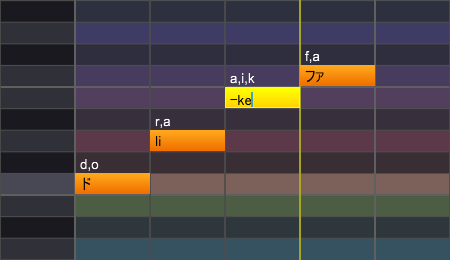
歌詞のまとめ入力
「歌詞のまとめ入力」ボタンを押下すると、「歌詞のまとめ入力」パネルが開きます。
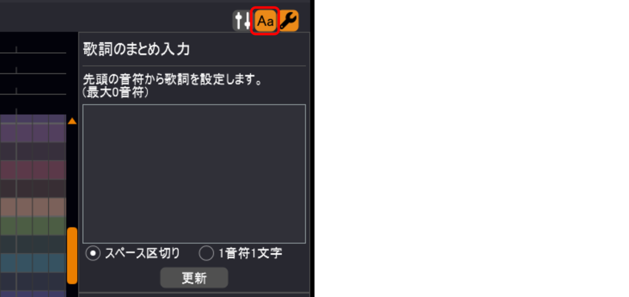
複数の音符に割り当てる歌詞を、まとめて入力することができます。
下のラジオボタンで「スペース区切り」を選択している場合は、スペースで区切られたまとまりを1つの音符に割り当てます。
「1音符1文字」を選択している場合は、1音符に1文字ずつ歌詞を割り当てます。
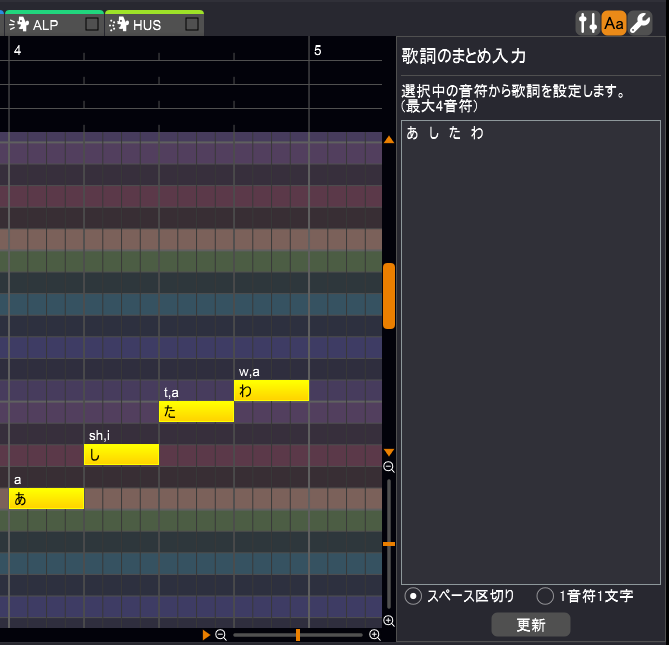
英語歌詞を入力することもできます。
1単語を複数の音符に割り当てたい場合は、後ろの音符の歌詞にハイフンをつけて入力します。
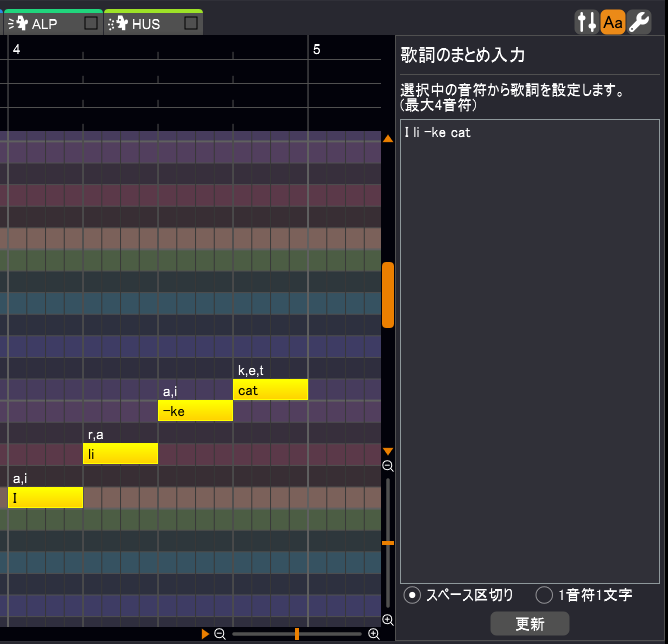
特殊な記号
母音脱落
全角「’」(アポストロフィ)を歌詞の後ろにつけることで母音を脱落させることができます。
歌詞を「いぇす」とした場合は「y, e, s, u」と発音しますが、「いぇす’」の場合は「y, e, s」となり、/u/が脱落します。
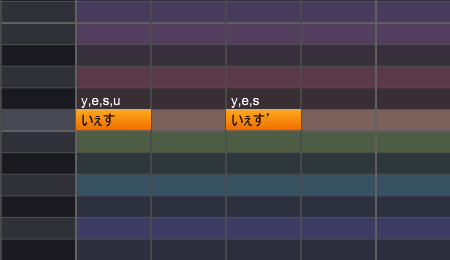
歌唱表現
VoiSonaでは、音声提供者ごとの特徴的な歌唱表現にラベリングした収録データで、AIをラーニングしています。それによって高精度なボイスライブラリを実現しています。
音符の右クリックメニューまたはプロパティから「歌唱表現」を指定することで、音声提供者ごとの特徴的な歌唱表現を再現することができます。
指定すると、音符の上にアイコンが表示されます。
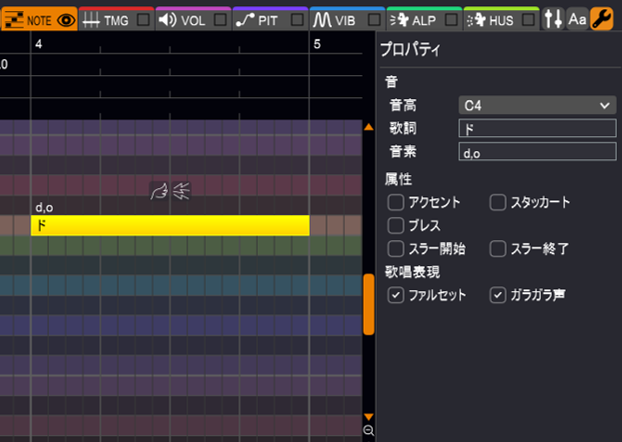
また、下記の「ラーニング時のラベリング記号」を音符歌詞に付加し、歌唱表現を指定することも可能です。
- ※ボイスライブラリやそのバージョン、歌詞や声の高さ等によって、特性の出やすさや出にくさが異なります。
- ※あくまでもラーニング精度を高めるための機構ですので、特性が出現しないこともあります。
- ※特性が定義されていない場合(空欄)でも、記号の入力により合成音声に何かしらの変化が起こる場合があります。
| 半角「$」 全角「$」 全角「※」 | 半角「@」 全角「@」 | 半角「^」 全角「^」 | 半角「%」 全角「%」 | 半角「=」 全角「=」 | 全角「_」 | ||
|---|---|---|---|---|---|---|---|
| 知声 | ファルセット | ガラガラ声 | |||||
| さとうささら | 1.x | ファルセット | |||||
| 2.x | ファルセット | 跳ね上げ | 先頭フォール | ||||
| 機流音 | ファルセット | 跳ね上げ | 巻き舌 | 先頭フォール | |||
| AiSuu | 1.x | ファルセット | 跳ね上げ | ||||
| 2.x | ファルセット | 跳ね上げ | 吐き捨て | 末尾フォール | |||
| Chis-A [tʃíːseɪ] | ファルセット | ガラガラ声 | |||||
| #kzn | ファルセット | ||||||
| 結月ゆかり麗 | ファルセット | ||||||
| MYK-IV | ファルセット | 跳ね上げ | ささやき | いきり | |||
| 双葉湊音 | 1.x | ファルセット | 跳ね上げ | 吐き捨て | |||
| 2.x | ファルセット | 跳ね上げ | 末尾フォール | 吐き捨て | |||
| すずきつづみ | ファルセット | ||||||
| Pepper | |||||||
| IA | ファルセット | 跳ね上げ | 抜き | ||||
| IA ENGLISH | ファルセット | ||||||
| OИE | ファルセット | ||||||
| Ci flower | 1.x | ファルセット | 跳ね上げ | ガラガラ声 | |||
| 2.x | ファルセット | 跳ね上げ | ガラガラ声 | 吐き捨て | |||
| たかむらひびき | ファルセット | 跳ね上げ | 吐き捨て | 先頭フォール | |||
| かざまつりあさひ | ファルセット | 跳ね上げ | ふるえ | 先頭フォール | |||
| こむらさきももか | ファルセット | 跳ね上げ | 吐き捨て | 先頭フォール | |||
| やまだかのん | ファルセット | 跳ね上げ | 先頭フォール | ||||
| 奏兎める | ファルセット | ガラガラ声 | ふるえ | ||||
| 玉姫 | ファルセット | 跳ね上げ | 先頭フォール | いきり | 末尾フォール | ||
| ずんだもん | ファルセット | ||||||
| 四国めたん | ファルセット | 跳ね上げ | |||||
| 東北ずん子 | ファルセット | 跳ね上げ | |||||
| 東北イタコ | 1.x | ファルセット | 跳ね上げ | ||||
| 2.x | ファルセット | 跳ね上げ | 末尾フォール | ||||
| 東北きりたん | ファルセット | 跳ね上げ | |||||
| りむる | ファルセット | 跳ね上げ | 吐き捨て | ||||
音素列の編集
音素の部分をダブルクリックすると、音素列を直接編集することができます。
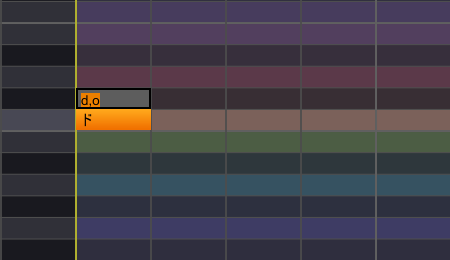
例) 「d, o」->「d, a」
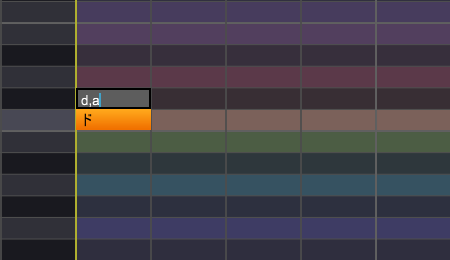
編集された音素列は緑色で表示されます。
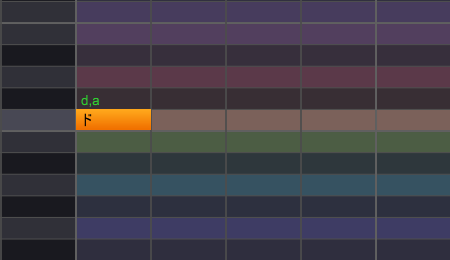
音素列編集時、音素パレットが表示されます。
パレット内の音素をクリックすることで、音素を入力することができます。
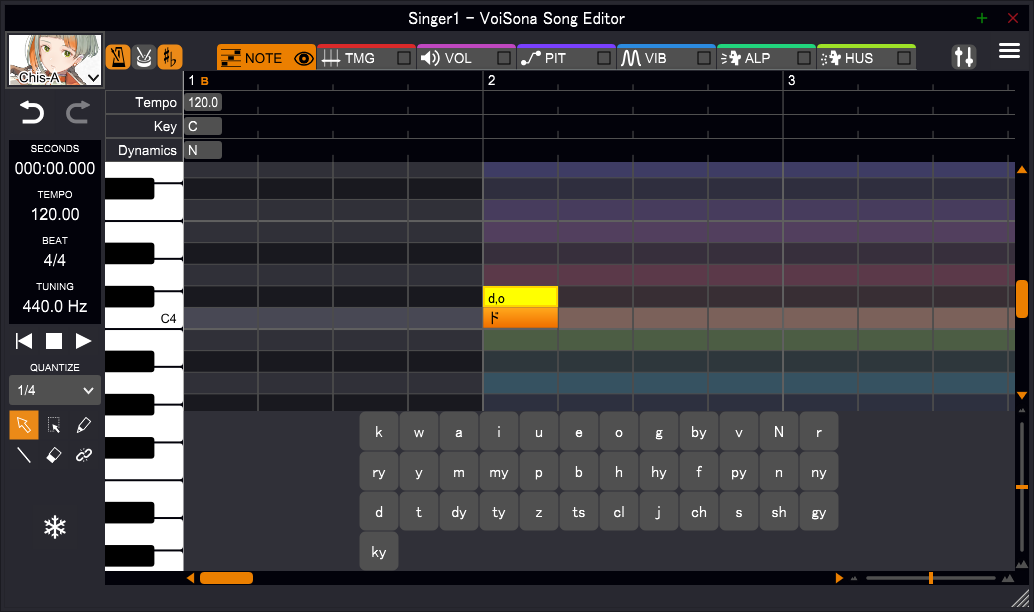
日本語の音素
| あ, アa | い, イi | う, ウu | え, エe | お, オo |
| か, カk,a | き, キk,i | く, クk,u | け, ケk,e | こ, コk,o |
| さ, サs,a | し, シsh,i | す, スs,u | せ, セs,e | そ, ソs,o |
| た, タt,a | ち, チch,i | つ, ツts,u | て, テt,e | と, トt,o |
| な, ナn,a | に, ニn,i | ぬ, ヌn,u | ね, ネn,e | の, ノn,o |
| は, ハh,a | ひ, ヒh,i | ふ, フf,u | へ, ヘh,e | ほ, ホh,o |
| ま, マm,a | み, ミm,i | む, ムm,u | め, メm,e | も, モm,o |
| や, ヤy,a | ゆ, ユy,u | いぇ, イェy,e | よ, ヨy,o | |
| ら, ラr,a | り, リr,i | る, ルr,u | れ, レr,e | ろ, ロr,o |
| わ, ワw,a | ゐ, ヰi | ゑ, ヱe | を, ヲo |
| が, ガg,a | ぎ, ギg,i | ぐ, グg,u | げ, ゲg,e | ご, ゴg,o |
| ざ, ザz,a | じ, ジj,i | ず, ズz,u | ぜ, ゼz,e | ぞ, ゾz,o |
| だ, ダd,a | ぢ, ヂj,i | づ, ヅz,u | で, デd,e | ど, ドd,o |
| ば, バb,a | び, ビb,i | ぶ, ブb,u | べ, ベb,e | ぼ, ボb,o |
| ぱ, パp,a | ぴ, ピp,i | ぷ, プp,u | ぺ, ペp,e | ぽ, ポp,o |
| きゃ, キャky,a | きゅ, キュky,u | きぇ, キェky,e | きょ, キョky,o | |
| しゃ, シャsh,a | しぃ, シィs,i | しゅ, シュsh,u | しぇ, シェsh,e | しょ, ショsh,o |
| ちゃ, チャch,a | ちゅ, チュch,u | ちぇ, チェch,e | ちょ, チョch,o | |
| てゃ, テャty,a | てぃ, ティt,i | てゅ, テュty,u | てょ, テョty,o | |
| にゃ, ニャny,a | にゅ, ニュny,u | にぇ, ニェny,e | にょ, ニョny,o | |
| ひゃ, ヒャhy,a | ひゅ, ヒュhy,u | ひぇ, ヒェhy,e | ひょ, ヒョhy,o | |
| みゃ, ミャmy,a | みゅ, ミュmy,u | みぇ, ミェmy,e | みょ, ミョmy,o | |
| りゃ, リャry,a | りゅ, リュry,u | りぇ, リェry,e | りょ, リョry,o | |
| ヴゃ, ヴャby,a | ヴゅ, ヴュby,u | ヴょ, ヴョby,o | ||
| ぎゃ, ギャgy,a | ぎゅ, ギュgy,u | ぎぇ, ギェgy,e | ぎょ, ギョgy,o | |
| じゃ, ジャj,a | じゅ, ジュj,u | じぇ, ジェj,e | じょ, ジョj,o | |
| びゃ, ビャby,a | びゅ, ビュby,u | びぇ, ビェby,e | びょ, ビョby,o | |
| ぴゃ, ピャpy,a | ぴゅ, ピュpy,u | ぴぇ, ピェpy,e | ぴょ, ピョpy,o | |
| でゃ, デャdy,a | でゅ, デュdy,u | でぇ, デェdy,e | でょ, デョdy,o |
| くぁ, クァk,w,a | くぃ, クィk,w,i | くぅ, クゥk,w,u | くぇ, クェk,w,e | くぉ, クォk,w,o |
| ぐぁ, グァg,w,a | ぐぃ, グィg,w,i | ぐぅ, グゥg,w,u | ぐぇ, グェg,w,e | ぐぉ, グォg,w,o |
| ぐゎ, グヮg,w,a |
| うぃ, ウィw,i | うぇ, ウェw,e | うぉ, ウォw,o | ||
| すぃ, スィs,i | ||||
| つぁ, ツァts,a | つぃ, ツィts,i | つぇ, ツェts,e | つぉ, ツォts,o | |
| とぅ, トゥt,u | ||||
| ふぁ, ファf,a | ふぃ, フィf,i | ふぇ, フェf,e | ふぉ, フォf,o | |
| ずぃ, ズィz,i | ||||
| どぅ, ドゥd,u | ||||
| ヴぁ, ヴァv,a | ヴぃ, ヴィv,i | ヴぅ, ヴゥv,u | ヴぇ, ヴェv,e | ヴぉ, ヴォv,o |
| ん, ンN | っ, ッcl |
英語の音素
英語の音素とIPA記号は以下に示す関係になっています。
| 音素 | IPA記号 |
|---|---|
| aa | ɑ |
| ae | æ |
| ax | ə, ɜ |
| axr | ər (ɚ), ɜr (ɝ) |
| ah | ʌ |
| ao | ɔ |
| aw | aʊ |
| ay | aɪ |
| b | b |
| ch | tʃ |
| d | d |
| dh | ð |
| eh | e, ɛ |
| ey | eɪ, ɛɪ |
| f | f |
| g | g |
| hh | h |
| ih | ɪ |
| iy | i |
| jh | dʒ |
| k | k |
| l | l |
| m | m |
| n | n |
| ng | ŋ |
| ow | oʊ |
| oy | ɔɪ |
| p | p |
| r | r |
| s | s |
| sh | ʃ |
| t | t |
| th | θ |
| uh | ʊ |
| uw | u |
| v | v |
| w | w |
| y | j |
| z | z |
| zh | ʒ |
| tt | t がフラッピングした音(better, little等) |
| dd | d がフラッピングした音(middle等) |
英単語のストレス情報は、母音の後ろに以下の記号を記載することで表現します。
・プライマリストレス:*~
・セカンダリストレス:*
ただし、歌声ではストレスを指定してもあまり合成音声が変わらないことが多いです。
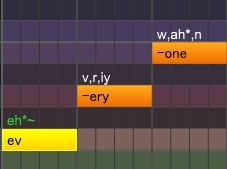
その他のプロパティ
「プロパティ」ボタンをクリックすると、「プロパティ」パネルが開きます。
選択中の音符やテンポ、拍子、調号、強弱記号に関する様々なプロパティを設定できます(一部ショートカットキーでも設定可能)。
特に、スラーは複数の音符を滑らかに繋げて歌わせたい場合に効果的です。
歌唱表現を指定すると、音声提供者の声の特性を引き出せる可能性があります。詳細は歌唱表現をご参照ください。
- ※ボイスライブラリや楽譜によっては、アクセント、スタッカート、スラー、歌唱表現の効果がわかりにくいことがあります。

まとめ選択
音符やタイミング、その他のパラメータをまとめて操作したいときは、まとめ選択ツールを選択します。
全てのパラメータに対して一括でコピーや削除などの操作をすることができます。
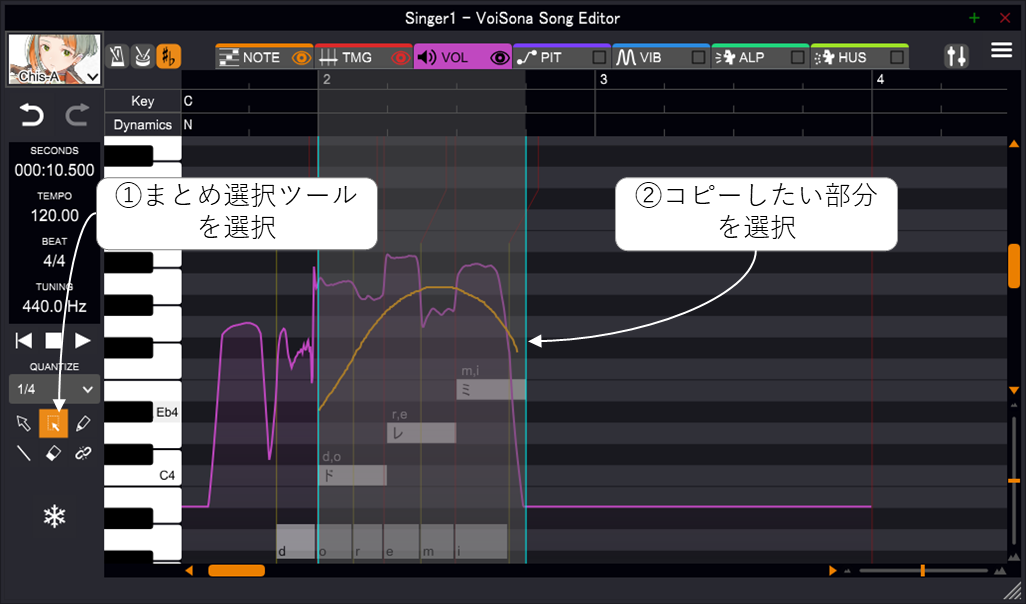
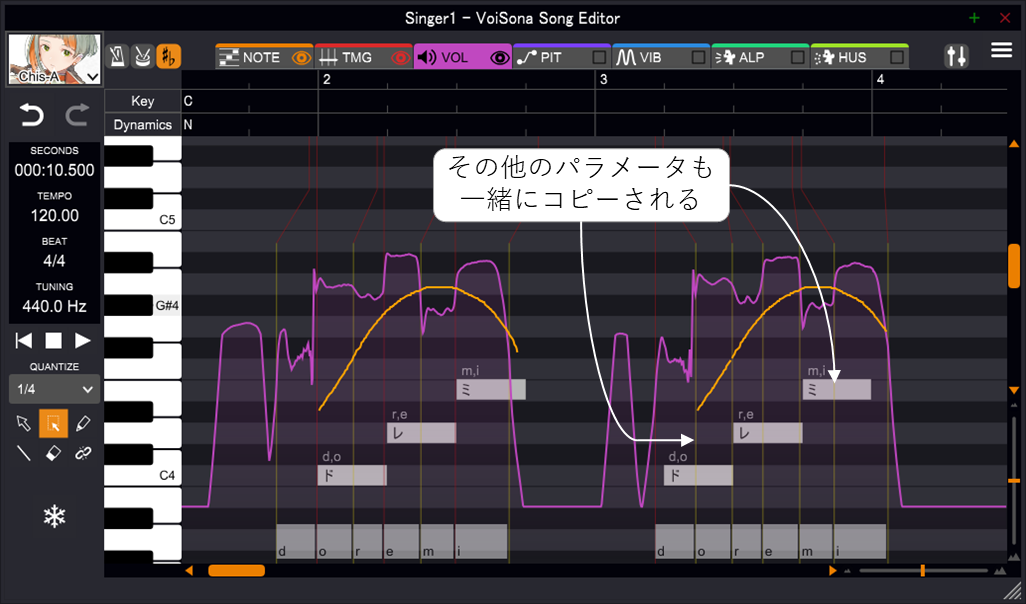
小節の編集
ピアノロールを右クリックして「小節」→「1小節挿入」/「複数小節挿入」を選択すると、再生位置を基準として任意の数の小節を挿入することができます。
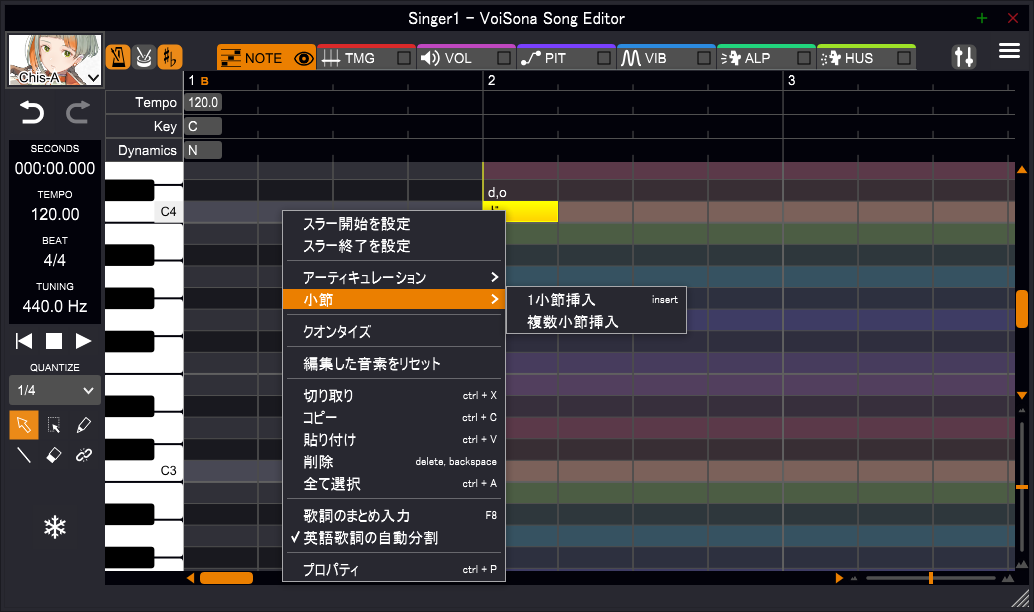
パラメータ調整
タブの説明

・TMG:タイミングの調整。
・VOL:ボリュームの調整。単位はdb(デシベル)。
・PIT:ピッチの調整。単位はHz(ヘルツ)。
・VIB:ビブラートの調整。
・ALP:声質の調整。値が小さいほど子供っぽく、大きいほど大人っぽい声。
・HUS:声質のハスキー具合の調整。値が大きいほどハスキーな声。
タイミングパラメータ調整
音素の開始/終了タイミングを調整します。
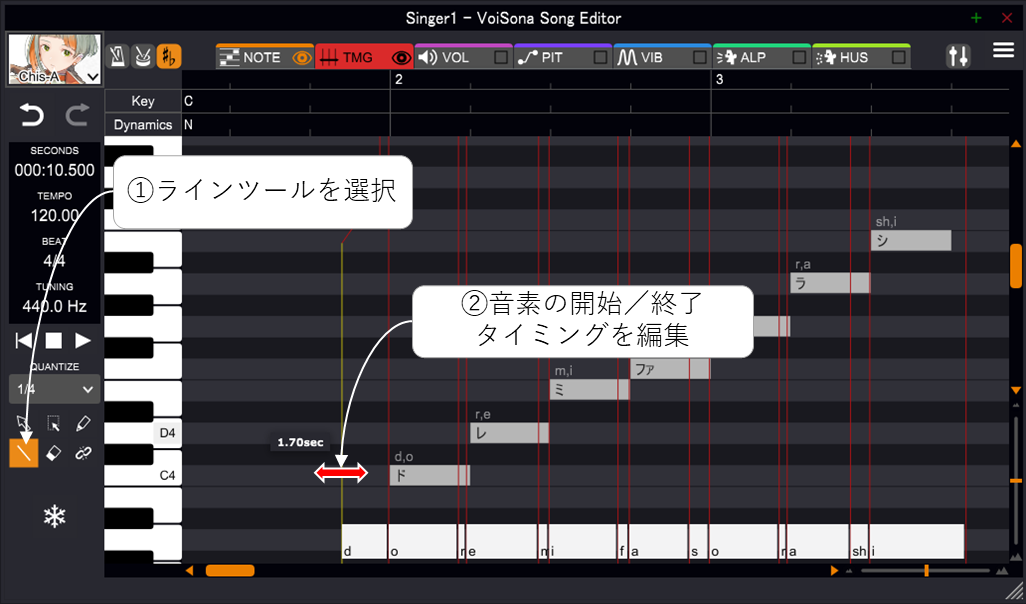
更に細かい単位で調整するには、環境設定の「エディタ」タブを開き、「タイミングの状態ライン」にチェックを入れてください。
※音素より細かい単位のタイミング調整は、効果が現れにくい場合もあります。
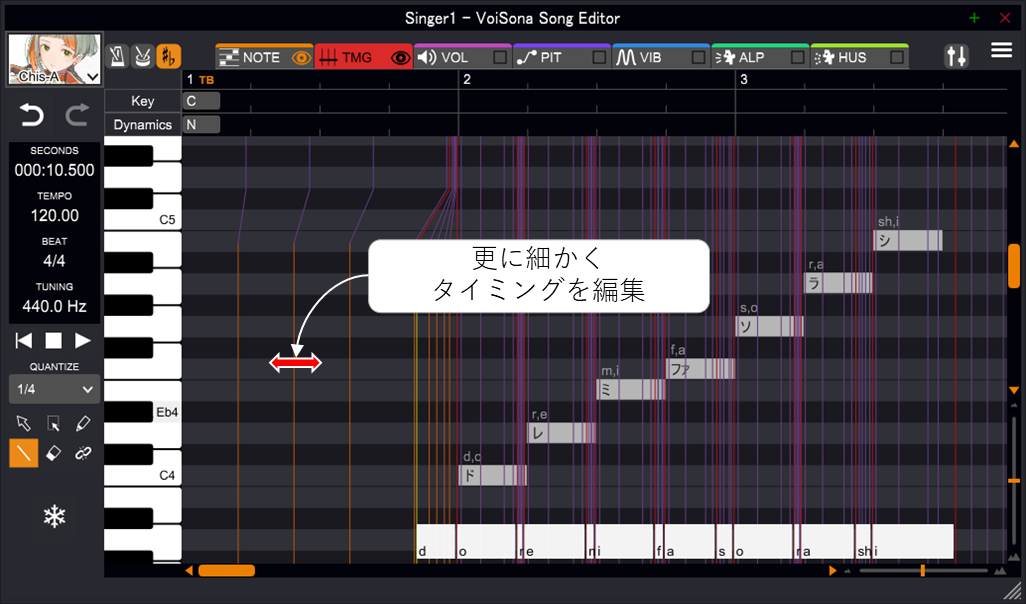
選択ツールで範囲を指定し、右クリックメニューから「母音のタイミング補正」を選択すると、母音が音符の先頭に来るようにタイミングを補正することができます。
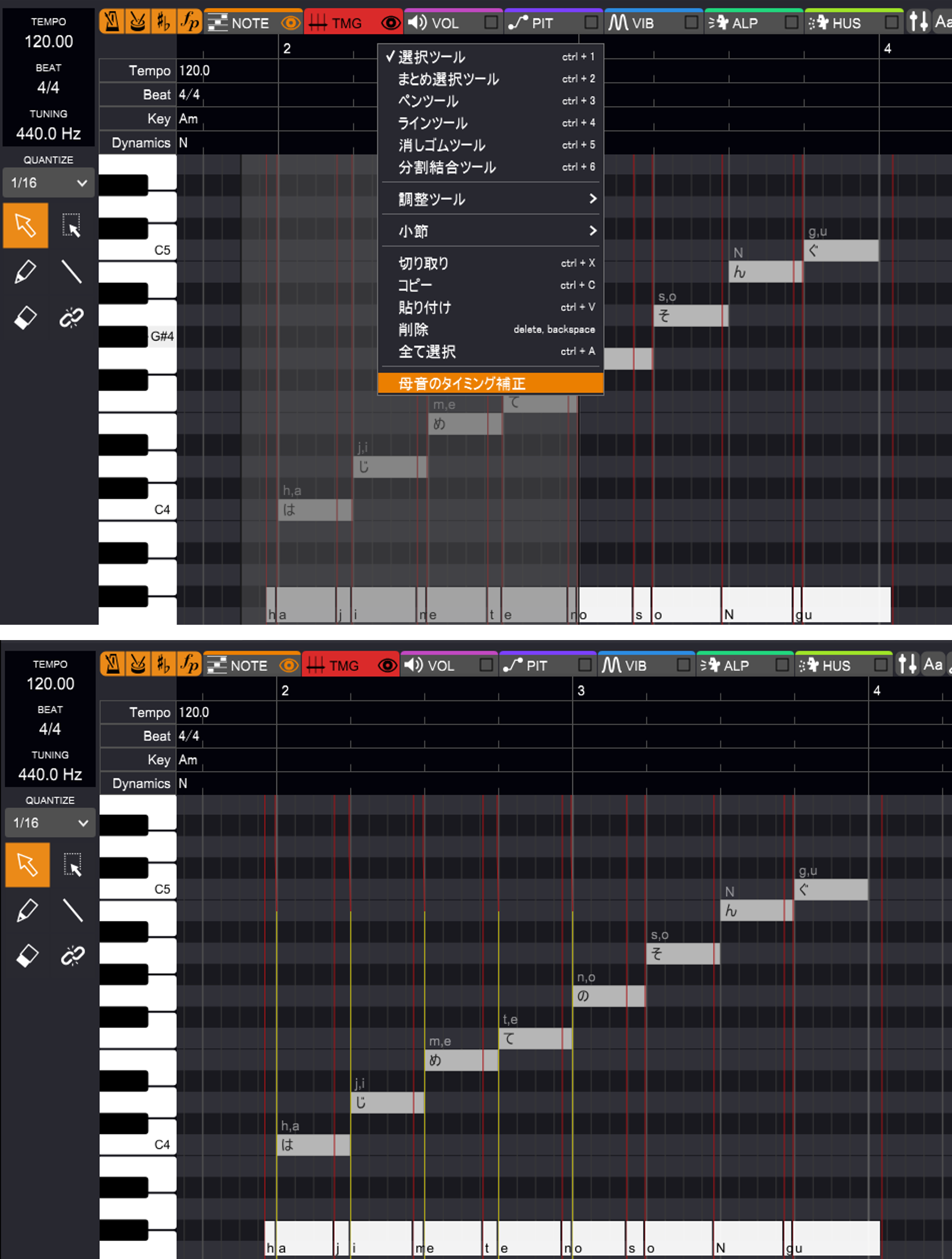
ビブラートパラメータ調整
ビブラートの調整は「Simplified」と「Detailed」の2モードあります。
画面右上のボタンでモードを切り替えることができます。
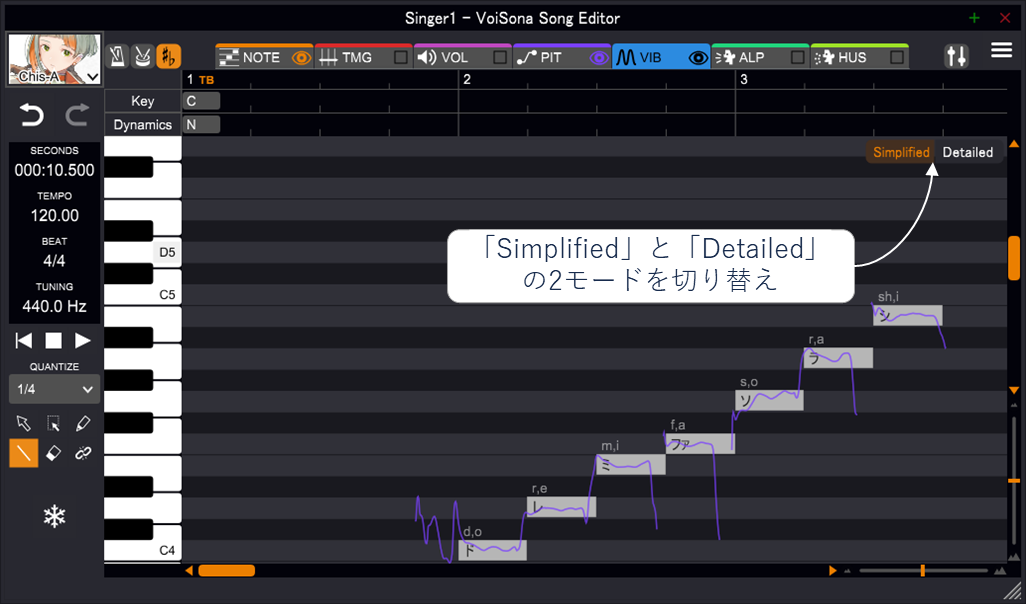
Simplifiedモードでは、ビブラートがかかっている区間が枠で表示されています。
この枠を操作することでビブラートを調整します。
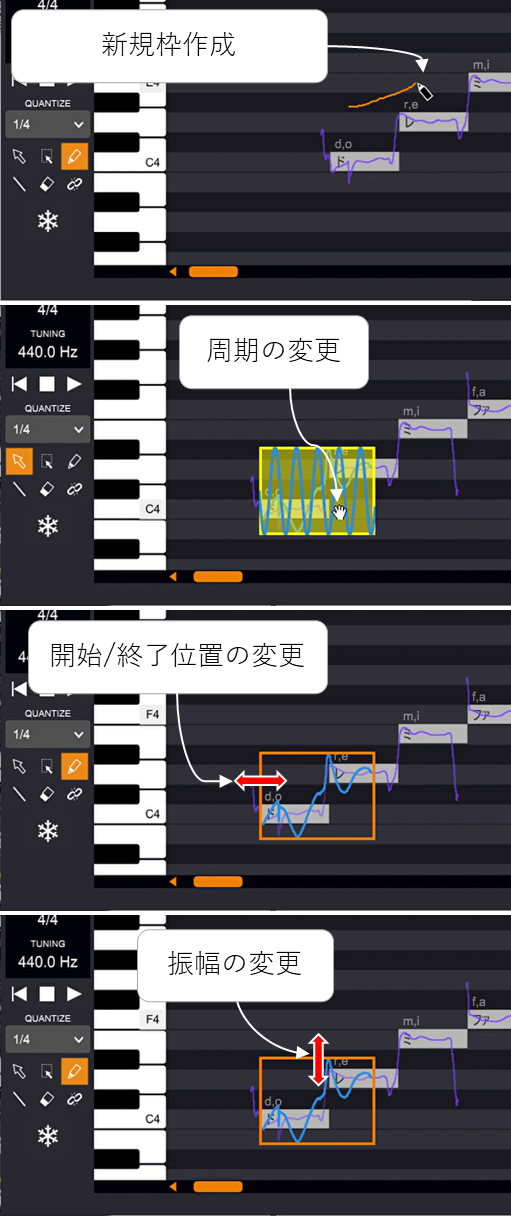
Detailedモードでは画面上部にてAMP(振幅:単位はCent、100Centで半音)、下部にてFRQ(周期:単位はHz)の調整をすることができます。
それぞれのパラメータはその他のパラメータ調整と同じ操作方法です。
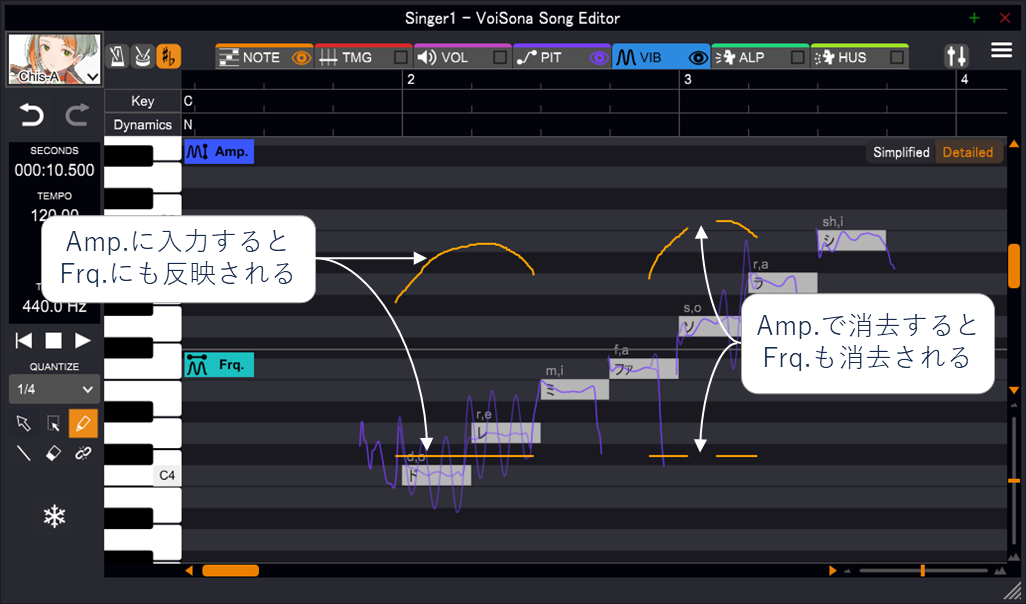
その他のパラメータ調整
VOL(ボリューム)、PIT(ピッチ)、ALP(声質)、HUS(ハスキー具合)のパラメータをそれぞれ調整します。
ピッチとビブラートの振幅/周期の調整画面では、Shiftキーを押しながらドラッグして元の値を削除(無効化)することもできます。
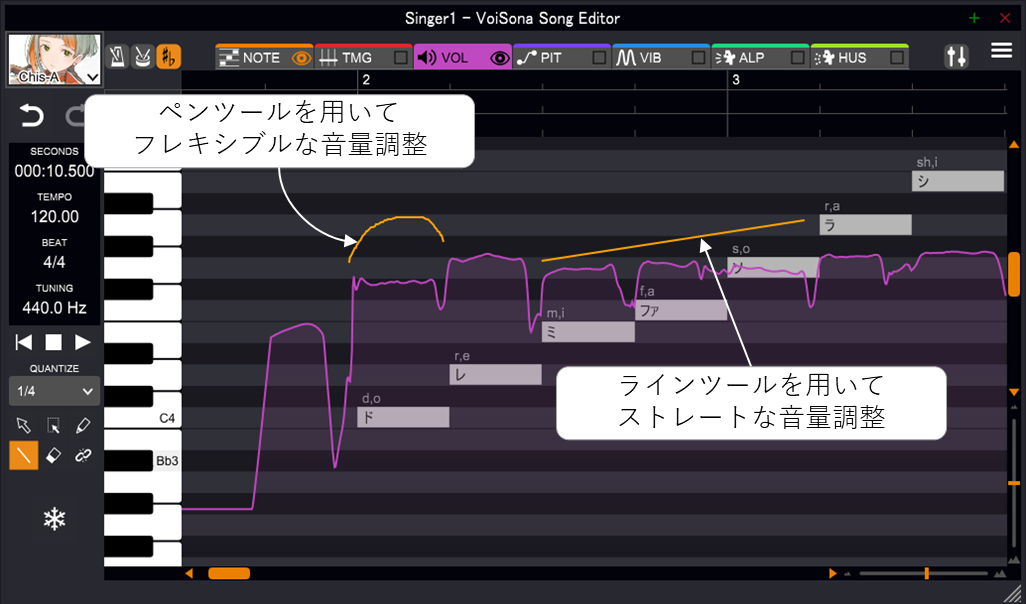
以下のようにすると、パラメータをコピーすることができます。
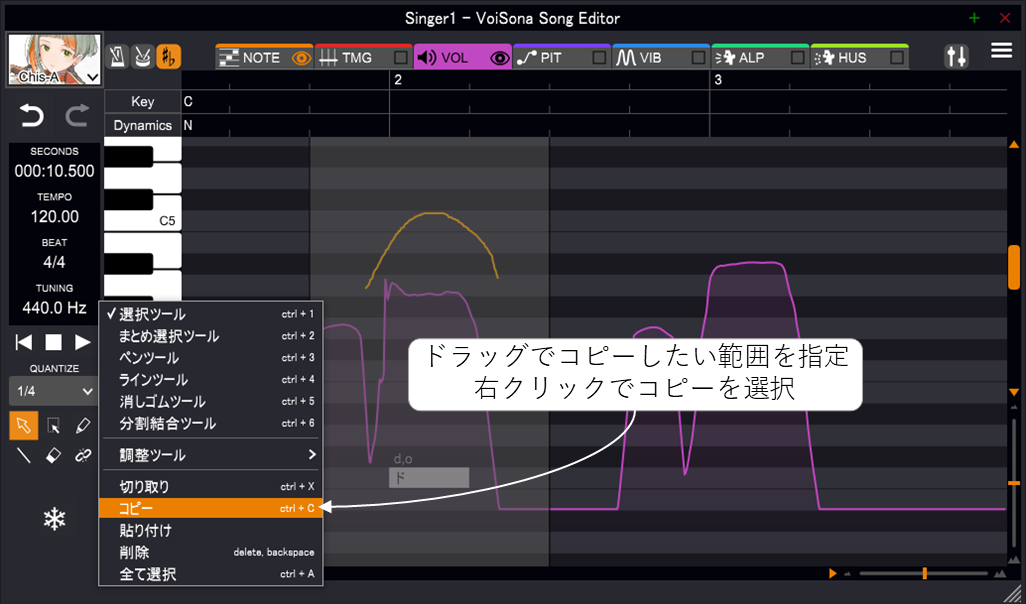
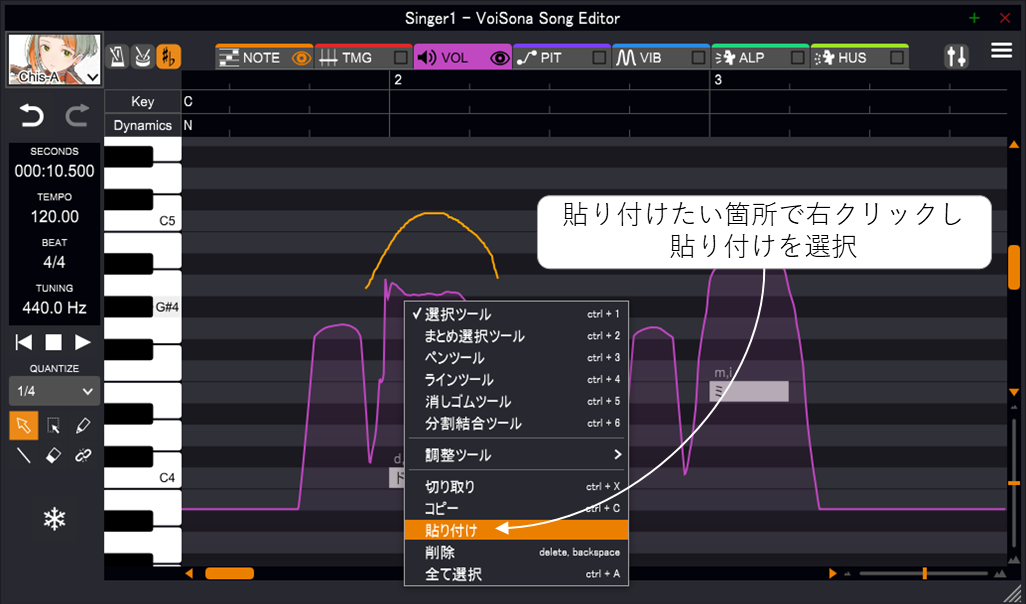
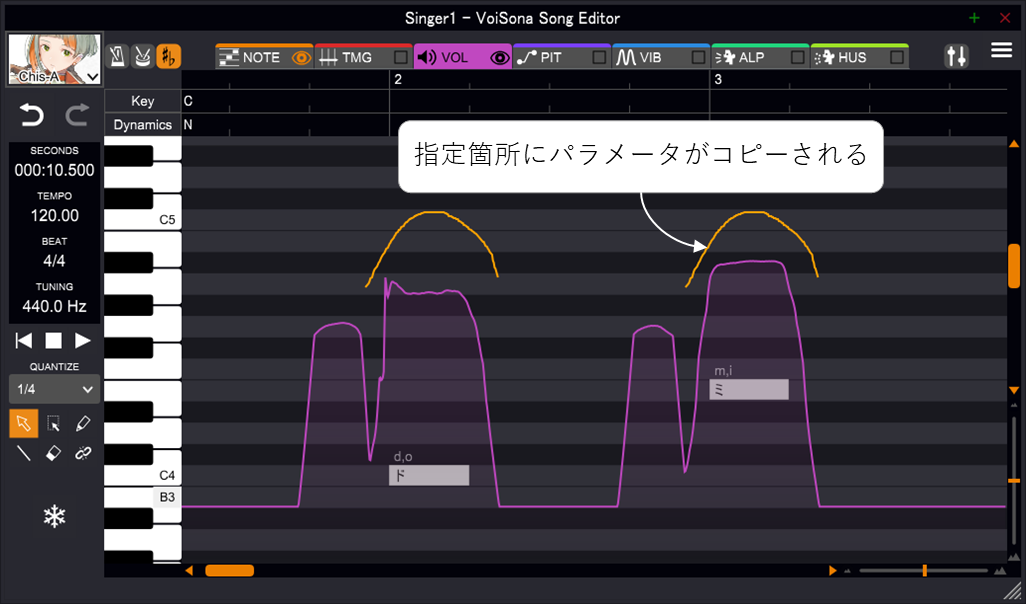
困ったとき
よくある質問
Q. CeVIO AI、CeVIO Creative Studioのボイスライブラリ製品は使えますか?
いいえ、ご利用頂けるのはVoiSona用にリリースされるボイスライブラリのみとなります。
CeVIO姉妹ブランドとして、ご要望の多いボイスライブラリは、前向きにVoiSonaへのクロスプラットフォーム化の検討をしていきたいと考えています。
Q. ログインパスワードを変更したいです。
アカウントページの「パスワードを変更する」から変更を行ってください。
Q. アカウント登録を解除したいです。
CONTACTページからお問い合わせください。
Q. ボイスライブラリをダウンロードできません。
本マニュアルの「スタンドアローンで利用する」および「ボイスライブラリの選択」をご覧いただき、改めてお試しいただけますでしょうか。
Q. ボイスライブラリの選択に失敗します。
一旦ボイスライブラリを削除し、再度ダウンロードしてお試しください。
Q. ショートカットキーが動作しません。
Appleシリコン搭載のMacにおいてLogic ProやGarageBand上でVoiSonaを実行すると、キーボードショートカットが動作しない場合があるようです。
DAWをRosettaモードで実行することで動作するようになります。
またVoiSonaをDAWのプラグインとしてご利用いただいており、DAW側で既にVoiSonaと同じショートカットキーが割り当てられてる場合、DAWのショートカットが優先されてVoiSonaのショートカットが動作しないことがあります。
その場合は、環境設定を開き、ショートカットタブからショートカットキーを変更してください。
Q. Altキーを併用したショートカットキーが動作しません。
一部のDAW(Studio One等)では、プラグイン側ではAltキーを併用したショートカットキーが動作しないようです。
その場合は、環境設定を開き、ショートカットタブからAltキーを併用しないショートカットキーに変更してください。
Q. 64分音符などの細かい音符は入力できないのでしょうか?
入力できるのは32分音符までとなりますので、細かい発声タイミングの編集は、タイミング(TMG)調整画面で行ってください。
その際に、ボリューム(VOL)タブの目のマークをONにしておくと、ボリュームのラインが表示され、TMGの調整がやりやすくなると思います。
Q. GarageBandで利用したらアクティベーション数が上限に達しました。
アクティベーション可能なPCの台数は2台で、1台のPC上では複数のDAWでご利用いただけますが、GarageBandは他のDAWと異なり、1台の別のPCとして認識されてしまいます。
そのため、お手数ですが、Webサイトのアカウントページよりアクティベーションを解除してからご利用ください。
Q. GarageBand上で、ダウンロードしたボイスライブラリを使用できません。
システム環境設定 → セキュリティとプライバシー → ダウンロードしたアプリケーションの実行許可 → ts_から始まるdylibを許可
でdylibの実行を許可してからお試しください。
dylibには署名が付いていますが、GarageBandのセキュリティが他のDAWより厳しく、署名付きのdylibであっても許可が必要となります。
新たなボイスライブラリをダウンロードして使用する際には、再度この手順が必要になる場合があります。
Q. ソングエディタ上で再生開始位置を指定することはできますか?
以下の手順で指定位置からの再生が可能です。
まず、編集画面のルーラー部分(強弱記号や調号が表示されている部分)をクリックし、再生開始位置を指定します。
次に、編集画面左側の再生ボタンをクリックすると、その位置から音声が再生されます。
ただし、多くのDAWではDAWの再生開始位置とは連動しておりませんので、DAW側で再生した場合は、編集画面上の位置指定は無視されます(スペースキーで再生した場合も)。
Q. ボイスライブラリのライセンスを解約するにはどうしたらよいですか?
ボイスライブラリのライセンスの自動更新をOFFにしてください。
ライセンスページ(要ログイン)から、ご契約中のボイスライブラリをご選択いただき、解約予約ボタンを押すことで自動更新をOFFにすることができます。
自動更新がOFFになると、ライセンスが「ステータス:解約予約中」という表示に変わり、契約期限が過ぎると解約されます。
なお、期限まではこれまで通りボイスライブラリをご利用いただけます。
Q.「VoiSona」と「VoiSona Talk」を両方利用する場合にアクティベーションに失敗する
アップデートにより、アクティベーションに必要なハードウェア情報の取得方法が変わったため、「VoiSona」と「VoiSona Talk」を共にご利用の場合は、両ソフトをアップデートしていただくようお願いいたします。
アップデート後にアクティベーションに失敗した場合は、アカウントページにて古いアクティベーション情報を解除してください。
Q. 「波形ジェネレータ Prototype A」を利用したいです。
日本語ソングボイスライブラリ「知声」でのみ利用可能な試験機能「波形ジェネレータ Prototype A」は、「知声」バージョン2.0のリリースにともない役割を終えたため、バージョン1.8.2のソングエディタを最後に搭載を終了しました。
なお「波形ジェネレータ Prototype A」を用いて制作いただいた音声波形を再現できるように、1.8.2のソングエディタは当面の間、ダウンロードページの一番下のリンクよりダウンロードすることができます。


